
National Registry of Exonerations
A project of the University of California Irvine • Newkirk Center for Science & Society,
the University of Michigan Law School, and Michigan State University College of Law
Race and Wrongful
Convictions in the
United States
2022
Samuel R. Gross, Senior Editor, srgross@umich.edu
Maurice Possley, Senior Researcher
Ken Otterbourg, Researcher
Klara Stephens, Research Fellow
Jessica Weinstock Paredes, Research Fellow
Barbara O’Brien, Editor
NATIONAL REGISTRY OF EXONERATIONS
SEPTEMBER 2022

Race and Wrongful Convictions
Page ii • National Registry of Exonerations • September 2022
Race and Wrongful Convictions
in the United States 2022
Preface
This Report is about the role of race in the conviction of innocent people. We discuss cases that
are listed in the National Registry of Exonerations, an ongoing online archive that includes all
known exonerations in the United States since 1989, 3,248 as of this writing. The Report
describes racial patterns in the first 3,200 individual exonerations in the Registry, those posted
by August 8, 2022. Information about individual exonerations we discuss may be found by
searching for the exonerees by name on the Registry website. Other data are readily available on
that site, or by request.
The Registry’s first report on race and wrongful convictions, which was made possible by a
generous grant from the Proteus Fund, was released in 2017. The current Report covers a great
deal more ground than we did five years ago. It includes many more details, more extensive and
better data throughout, and several parts are entirely new.
The number of exonerations we consider has grown by almost 70% since 2017, 3,200 compared
to 1,900, which makes the patterns we detect more reliable as well as more current. In the
intervening five years we also completed a thorough study of Government Misconduct and
Convicting the Innocent; as a result, our discussion of misconduct by police and prosecutors in
this Report is more detailed and informative.
This is the first Report by the Registry that includes extensive discussion of changes over time.
That required patience. Many, probably most, of the important changes are in the investigations
and prosecutions that produce false convictions—but we don’t begin to learn about them until
the convicted defendants are exonerated, on average 11.6 years later. We’re now able to describe
and analyze changes that occurred in the twenty-first century. For example, many innocent
Black men used to be convicted of rape after they were misidentified by the white victims, but
DNA pre-trial testing has now reduced that problem to a fraction of what it once was.
Finally, we know far more about false drug crime convictions than we did five years ago. We
have two-and-a-half-times as many exonerations (554 vs. 221), including 259 drug crime
exonerees, overwhelmingly Black people, who were framed by police. And we have additional
data on thousands of defendants—again, primarily Black people—who were wrongfully
convicted of drug crimes by systematic practices of misconduct by police officers.
Samuel R. Gross
Maurice J. Possley
Ken Otterbourg
Klara Huber Stephens
Jessica Weinstock Paredes
Barbara O’Brien
September 23, 2022

Race and Wrongful Convictions
Page iii • National Registry of Exonerations • September 2022
Executive Summary
I. Introduction
• Black people are 13.6% of the American population but 53% of the 3,200 exonerations
listed in the National Registry of Exonerations. Judging from exonerations, innocent
Black Americans are seven times more likely than white Americans to be falsely
convicted of serious crimes.
• We see this racial disparity, in varying degrees, for all major crime categories except
white collar crime. This report examines racial disparities in the three types of crime
that produce the largest numbers of exonerations: murder, sexual assault, and drug
crimes.
• For both murder and sexual assault, there are preliminary investigative issues that
increase the number of innocent Black suspects: for murder, the high homicide rate in
the Black community; for rape, the difficulty of cross-racial eyewitness identification.
For both crimes, misconduct, discrimination and racism amplify these initial racial
discrepancies.
• For drug crimes, the preliminary sorting that increases the number of convictions of
innocent Black suspects is racial profiling. In addition, the Registry lists 17 “Group
Exonerations” including 2,975 additional wrongfully convicted defendants, many of
whom were deliberately framed and convicted of fabricated drug crimes in large-scale
police scandals. The overwhelming majority are Black.
II. Murder
• Innocent Black people are about seven-and-a-half times more likely to be convicted of
murder than innocent white people. That applies equally to those who are sentenced
to death and those who are not.
• A major cause of this disparity is the high homicide rate in the Black community, a
tragedy that kills many Black people and sends many others to prison. Like the
families of those who are killed, innocent defendants who are falsely convicted are
victims who are deeply harmed by murders committed by others.
• In addition, Black people who are convicted of murder are about 80% more likely to
be innocent than other convicted murderers.
• Part of that disparity is tied to the race of the victims. About 13% of murders by Black
people have white victims, but twice as many—26% of innocent Black murder
exonerees— were convicted of killing white people.
• The convictions that led to murder exonerations with Black defendants were almost
50% more likely to include misconduct by police officers than those with white
defendants.

Race and Wrongful Convictions
Page iv • National Registry of Exonerations • September 2022
• In addition, on average Black murder exonerees spent three years longer in prison
before release than white murder exonerees.
• The number of murder exonerations has been increasing, and many of the recent
exonerees are Black murder defendants who spent decades in prison. Most of these
long-serving Black murder defendants were exonerated by a handful of big-city
prosecutorial conviction integrity units (CIUs). More are likely on the way.
• Many of the convictions of Black murder exonerees were influenced by racial
discrimination, from unconscious bias and institutional discrimination to explicit
racism.
• Most innocent defendants who are convicted of crimes are not exonerated. Judging
from the rate of false conviction among death sentences, at least several thousand
defendants have been falsely convicted of murder in America in the past 40 years.
Judging from the exonerations that have occurred, more than half of them were Black.
III. Sexual Assault
• Innocent Black people are almost eight times more likely than white people to be
falsely convicted of rape. A prisoner serving time for sexual assault is more than three
times more likely to be innocent if he is Black than if he is white.
• The major cause of this huge racial disparity is the high danger of misidentification of
Black suspects by white victims of violent crimes.
• Assaults on white women by Black men are a small minority of all sexual assaults in
the United States, but nearly half of sexual assaults with eyewitness misidentifications
that led to exoneration.
• Eyewitness misidentifications do not completely explain the racial disparity in rape
exonerations. Some of the misidentifications were obtained by deliberately tainted
identification procedures, and Black men are also overrepresented in rape
exonerations without misidentifications.
• A substantial number of the convictions that led to rape exonerations of Black
defendants were marred by implicit biases, racially tainted official misconduct and, in
some cases, explicit racism.
• Black sexual assault exonerees received much longer prison sentences than white
sexual assault exonerees, and spent, on average, more than four years longer in prison
before exoneration.
• Exonerations of misidentified rape defendants are much less common than they used
to be. There have been only two from rape convictions in the last 12 years. That’s
because DNA testing is now routinely used to determine the identity of rapists before
trial. This technology has prevented convictions of hundreds or thousands of innocent
rape suspects, mostly Black men who were accused of raping white women.

Race and Wrongful Convictions
Page v • National Registry of Exonerations • September 2022
IV. Drug Crimes
• Sixty-nine percent of drug crime exonerees are Black and 16% are white. That means
that innocent Black people are 19 times more likely to be convicted of drug crimes
than innocent whites—a much larger disparity than we see for murder and rape—
despite the fact that white and Black Americans use illegal drugs at similar rates.
• Because drug crimes are almost never reported to police, the police choose who to
pursue for drug offenses—and they choose to stop, search and arrest Black people
several times more often than whites. That’s racial profiling. One of its deplorable
consequences is drug crime convictions of innocent Black defendants.
• Most false drug crime convictions involve comparatively low level charges and
sentences that rarely attract the effort necessary to obtain exonerations. Almost all the
erroneous drug convictions we know about are in a single cluster in Harris County,
Texas (Houston), where a unique practice of testing alleged drugs after defendants
pled guilty led to 157 exonerations; 62% of the exonerees are Black in a county with
20% Black residents.
• These convictions are errors—mostly caused by defective field drug tests—but most
are not innocent errors. Most Black exonerees were stopped and searched—and
subjected to the risk of these errors—because of their race.
• We also know of dozens of groups of innocent defendants who were deliberately
framed by police officers who planted drugs on them. Almost all are Black people or
other racial or ethnic minorities. So far, we list 259 individual exonerees who were
convicted of these fabricated drug crimes, primarily in three group exonerations; 87%
of them are Black.
• There are many more such cases in dozens of groups across the country. These
numbers will rise as we are able to add them to our lists.
• It’s no mystery why these outrageous programs of framing innocent drug defendants
target Black people. Guilty or innocent, drug law enforcement always focuses
disproportionately on Black people. Of the many costs that the war on drugs inflicts
on the Black community, the practice of deliberately charging innocent defendants
with fabricated crimes may be the most shameful.

Race and Wrongful Convictions
Page vi • National Registry of Exonerations • September 2022
Race and Wrongful Convictions in the United States 2022
Table of Contents
I.
I. Introduction ............................................................................. 1
II. Murder .................................................................................... 3
1. Racial patterns in murders and exonerations .................................................... 3
2. Additional racial disparities in murder exonerations ........................................ 4
a) Race of victim ...................................................................................................................... 4
b) Misconduct and delay ......................................................................................................... 6
c) Changes over time ............................................................................................................... 9
d) Intentional and structural discrimination ......................................................................... 15
3. The net effect ...................................................................................................... 17
III. Sexual Assault ........................................................................ 18
1. Race and false conviction for rape ..................................................................... 18
2. Eyewitness misidentification ............................................................................. 19
3. Misconduct and discrimination ........................................................................ 20
a) Tainted identifications ...................................................................................................... 20
b) Rape exonerations without eyewitness misidentifications ............................................... 21
c) Racism and discrimination ............................................................................................... 22
4. Sentencing and time in prison before exoneration .......................................... 23
5. Changes over time ............................................................................................. 24
IV. Drug Crimes ........................................................................... 27
1. The structure of drug crime enforcement ..........................................................27
2. Race and drug crime prosecutions ................................................................... 28
3. Innocent drug crime defendants ....................................................................... 29
4. Clusters of drug crime exonerations ................................................................. 30

Race and Wrongful Convictions
Page vii • National Registry of Exonerations • September 2022
a) Error: post-guilty plea drug testing exonerations in Harris County ................................. 31
b) Misconduct: Group Exonerations ...................................................................................... 31
c) Patterns over time ............................................................................................................. 32
5. Mistaken convictions discovered after guilty pleas in Harris County, Texas .. 33
6. Fabricated Drug Crimes in Group Exonerations .............................................. 36
a) The nature and number of group exonerations ................................................................ 36
b) Group exonerations and the individual Registry .............................................................. 40
c) The impact of the police misconduct ................................................................................ 42
d) Why do these scandals happen? ....................................................................................... 43
V. Conclusion ............................................................................ 45
VI. Appendix ............................................................................... 46

Race and Wrongful Convictions
Page 1 • National Registry of Exonerations • September 2022
I. Introduction
Race is central to every aspect of criminal justice in the United States. The conviction of
innocent defendants is no exception. Thousands of exonerations across dozens of years
demonstrate that Black people are far more likely than white people to be convicted of crimes
they did not commit.
As of August 8, 2022, the National Registry of Exonerations listed 3,200 defendants who were
convicted of crimes in the United States and later exonerated because they were innocent;
1
53%
of them were Black, nearly four times their proportion of the population, which is now about
13.6%.
2
Judging from exonerations, innocent Black Americans are seven times more likely than
white Americans to be falsely convicted of crimes.
Black people are over-represented to a greater or lesser extent among exonerations for all major
crime categories listed in the Registry, except white collar crimes. See Table 1.
3
Table 1: Exonerations by Race of Defendant and Type of Crime
(N=3,200)
White
Black
Hispanic
Other
Total
Murder
(1,167)
32%
55%
12%
2%
100%
Sexual Assault
(350)
33%
59%
7%
1%
100%
Child Sex Abuse
(310)
60%
28%
10%
2%
100%
Robbery (151) 19% 64% 15% 2% 100%
Other Violent Crimes (342) 42% 39% 13% 6% 100%
Drug Crimes (554) 16% 69% 14% 1% 100%
White Collar (77) 79% 10% 3% 8% 100%
Other Non-Violent Crimes
(249)
28%
52%
16%
5%
100%
All Crimes (3,200)
33%
53%
12%
2%
100%
1
All National Registry data reported in this paper are as of August 8, 2022, when the Registry listed 3,200 individual
exonerations. Information about any individual exonerations we discuss may be found by searching for the exonerees
by name on the Registry web site.
2
United States Census Bureau, QuickFacts, 2021.
3
As used in Table 1, on the Registry, and throughout this report, the categories “white” and “Black” do not include
individuals who identify themselves as Hispanic or Latino. We do not discuss false convictions and exonerations of
Hispanic or Latino defendants (except in a few places); the same applies to Asian and Indigenous defendants, and to
all other defendants who are grouped together in Table 1 in the column labeled “Other.” To study them separately we
would need national criminal justice statistics on reported crimes, arrests, convictions and imprisonment, and the
studies that are available use inconsistent standards for tabulating those racial and ethnic categories, suffer from high
rates of missing data, or fail to address the issue entirely.

Race and Wrongful Convictions
Page 2 • National Registry of Exonerations • September 2022
Nearly 3,000 additional defendants who were wrongfully convicted of crimes in 17 large-scale
police misconduct scandals were cleared in “Group Exonerations;” the great majority of those
defendants were also Black. Judging from the cases we know, a large majority of all innocent
people who are convicted of crimes in the United States are Black.
What explains this stark racial disparity? We examine this question by looking at exonerations
for murder, sexual assault and drug crimes, the three types of crime that produce the largest
numbers of exonerations. What we see—as so often in considering the role of race in America—is
complex and disturbing, familiar yet often ignored.
There is no one explanation for the heavy concentration of Black defendants among those
convicted of crimes they did not commit. The causes we have identified run from inevitable
consequences of patterns in crime and punishment to deliberate acts of racism, with many steps
in between. They differ sharply from one type of crime to another.
A major cause of the high number of Black murder exonerations is the high murder rate in the
Black community—a tragedy that kills many Black people and sends many others to prison.
Exonerated defendants go to prison, but not because they deserve to; they, like those who are
killed, are innocent victims of crimes committed by others. But homicide rates alone do not
explain the high number of Black people who were falsely convicted of murder or the length of
time they spent in prison before release. Misconduct and discrimination also played major roles.
Most innocent Black defendants who were exonerated for sexual assault had been convicted of
raping white women (128/207). The leading cause of these false convictions was mistaken
eyewitness identifications (101/128)—a notoriously error-prone process when white Americans
are asked to identify Black strangers. As with murder exonerations, however, the leading cause
is far from the only one. We see clear evidence of racial bias, ranging from unconscious bias to
explicit racism. And, as with murder if not more so, Black sexual assault exonerees spent more
time in prison than their white counterparts.
Prosecutions for drug offenses are very different from murder and rape cases. A murder or rape
investigation is initiated when a violent crime is reported to the police. Drug transactions and
drug possession have no immediate victims and are almost never reported. Instead, police have
essentially unlimited discretion to choose how and where to enforce drug laws—and against
whom, which opens the door to pervasive discrimination.
We see the effects in two settings. Because of racial profiling, Black people are more likely to be
stopped, searched, arrested and prosecuted in routine drug possession cases; as a result, they
are also more likely to be convicted by factual mistakes. Many false drug convictions, however,
are not mistakes. Black people are also the main targets in a shocking series of scandals in which
police officers systematically framed innocent defendants for drug crimes that never occurred.

Race and Wrongful Convictions
Page 3 • National Registry of Exonerations • September 2022
II. Murder
About half of those who are parties to homicide in the United States—those who kill and
those who are killed—are Black, seven times the rate for the remainder of the
population. One of the predictable consequences of this national calamity is that a
comparably high proportion of innocent defendants who are convicted of murder are
also Black.
The high homicide rate in the Black community accounts for most of the
overrepresentation of Black people among murder exonerees—but not all. Black
murder defendants are not only more numerous than whites, they are also more likely
to be innocent, especially if the victims were white. Many of the investigations and
prosecutions that lead to convicting innocent Black murder suspects are marked by
racial discrimination, including explicit racism.
Black murder exonerees are more likely than white murder exonerees to be the victims
of misconduct by police officers, and they spend more time in prison before
exoneration. We don’t yet know the extent of these differences. The number of murder
exonerations has been increasing in recent years, and many of the exonerations that
are being added are for murder defendants—overwhelmingly Black—who remained in
prison since they were convicted 25 to 40 years ago, or longer. Most of these recent
exonerations of innocent Black murder defendants who spent decades in prison are the
work of a handful of big-city prosecutorial conviction integrity units—and more, it
seems, are on the way.
1. Racial patterns in murders and exonerations
Fifty-five percent of all defendants exonerated for murder are Black people (628/1,167), who
make up 13.6% of the population of the United States.
4
For the population at large, that’s about
seven-and-a-half times the rate for whites, who comprise 59.3% of the population
5
but only 32%
of murder exonerations. Much of this racial disparity can be traced to a comparable disparity in
murder convictions. Black people are more than seven times more likely to be imprisoned for
4
United States Census Bureau, QuickFacts, 2021
5
Id.

Race and Wrongful Convictions
Page 4 • National Registry of Exonerations • September 2022
murder than white people,
6
and more than six times as likely to be killed in a homicide.
7
Murder
in America is overwhelmingly intra-racial: 84% of white murder victims and 93% of Black
murder victims are killed by members of their own race.
8
This high murder rate means that Black people are far more likely than white people to be
investigated, arrested and convicted of murder. Mostly, those who are investigated and
convicted are guilty. But innocent Black people also face a much higher risk of being suspected
of murder, and of being investigated, arrested and sometimes convicted despite their innocence.
Innocent Black murder suspects, especially those who are falsely convicted—like the families of
those who are killed—are additional victims of murders committed by others. Those who have
been exonerated spent on average almost 16 years in prison before they were released. Many
more have not been exonerated at all; more often than not, they will die in prison.
Innocent Black people are about equally overrepresented among murder exonerees who were
sentenced to death, 56% (74/134); those sentenced to life imprisonment, with or without the
possibility of parole, 55% (294/535); and those sentenced to imprisonment for terms shorter
than life, 54% (270/497). However, innocent Black defendants who escaped sentences of death
or life imprisonment received sentences that averaged 35 years, compared to 28 years for white
murder exonerees who were sent to prison for terms less than life.
2. Additional racial disparities in murder exonerations
Differences in homicide rates may explain most of the enormous racial disparity in exoneration
rates for murder, but not all. Forty percent of defendants imprisoned for murder are Black,
9
compared to 55% of murder exonerations. Unless some unknown and improbable process gives
innocent Black prisoners a big advantage in obtaining exonerations, that means that Black
people who are convicted of murder are about 80% more likely to be innocent than other
convicted murderers.
a) Race of victim
About 38% of murder victims in the United States are white.
10
The proportion of murder
exonerees of all races who were convicted of killing white victims is somewhat higher, 46%
6
E. Ann Carson, Prisoners in 2020 – Statistical Tables, Bureau of Justice Statistics, U.S. Dep’t of Justice; Tables 15
&18, pp. 29, 33. The numbers of prisoners reported in this study by the United States Bureau of Justice Statistics are
estimates of the prison population on a particular date, in this case December 31, 2019. So are most of the general
statistics we discuss on arrest, conviction and imprisonment. The murder exonerations to which we compare these
numbers are based on convictions that occurred over decades, from the 1960s through 2016—almost all since
1980—and the proportions of crimes and convictions by race have varied over that period. As a result, throughout
this report, all rates and comparisons we discuss that depend on general criminal justice statistics are estimates or
illustrations.
7
Bureau of Justice Statistics, U.S. Dep’t of Justice. Homicide Trends in the United States, 1980-2008. (November
2011): p. 3, Table 1. The rates of homicide victimization by race reported in this study are for all Black and white
victims, including those who identify as Hispanic or Latino, or other racial categories.
8
Id. p. 13; Sherman, Amy. An updated look at statistics on black-on-black murders. PolitiFact Florida. (May 2015).
9
E. Ann Carson, Prisoners in 2020 – Statistical Tables, Bureau of Justice Statistics, U.S. Dep’t of Justice; p.30,
Table 5.
10
The only national statistics on the race of murder victims come from the FBI’s Supplementary Homicide Reports.
These data have three limitations: (i) They are incomplete. (ii) They combine murder and non-negligent
manslaughter. (iii) They do not identify Hispanic or Latino victims, so their racial categories—“white” and “black”—are

Race and Wrongful Convictions
Page 5 • National Registry of Exonerations • September 2022
(537/1,167).
11
The concentration of murder defendants who were convicted of killing white
victims is considerably greater among exonerees who were sentenced to death, 66% (89/134).
Many studies in at least 15 states have shown that defendants who are charged with killing white
victims, regardless of their own race, are more likely to be sentenced to death than those
charged with killing Black victims.
12
Since 1976, 75% of executions in the United States were for
murders of white victims.
13
The disparities we see in our data suggest that innocent defendants
who are charged with killing white victims are more likely to be sentenced to death, and
sometimes no doubt executed, than those charged with killing Black victims.
There are also sentencing disparities among murder exonerees who avoided death sentences.
More than half of non-capital murder exonerees were sentenced to life imprisonment,
14
or to life
without the possibility of parole (535/1,033), and the rest were sentenced to prison for terms
shorter than life. Fifty-eight percent of non-capital murder exonerees who were convicted of
killing white victims were sentenced to life imprisonment (262/448), compared to 46% of those
who were convicted of killing Black victims (206/444).
In other words, judging from exonerations, the pattern of harsh sentencing for murder
convictions with white victims and lighter sentencing for those with Black victims is not
restricted to death sentences. If they avoid the death penalty, innocent murder defendants in
white-victim cases are also more likely to be sentenced to life in prison than those charged with
killing Black victims.
The race-of-victim disparity in murder exonerations also interacts with the race-of-defendant
disparity. Only about 13% of murders by Black people have white victims,
15
but 26% of innocent
Black murder exonerees were convicted of killing white people (168/638). This is a considerable
disparity; it could explain most or all of the difference in murder exonerations by race beyond
general homicide rates.
Part of the explanation for the high number of Black murder exonerees who were convicted of
killing white victims may be the perils of cross-racial eyewitness identification. We discuss that
not limited, as ours are, to non-Hispanic white and Black victims. The estimate in the text is the average percent of
“white” victims reported by the FBI from 2001 through 2010, multiplied by 0.79 to correct for the 21% of “whites” who
were identified as Hispanic or Latino in the 2010 census. U.S. Census Bureau. QuickFacts - United States.
11
We classify a murder exoneration as a “white victim” case if it included at least one murder victim who was white.
Eighteen cases in the Registry with multiple murder victims had both at least one white victim and at least one Black
victim each. They are coded as white victim cases.
12
For reviews of the literature on this issue, see Grosso, Catherine M., Barbara O’Brien, Abijah Taylor, and George
Woodworth. “Race Discrimination and the Death Penalty: An Empirical and Legal Overview.” America's Experiment
with Capital Punishment 525 (James R. Acker, Robert M. Bohm, & Charles S. Lanier, eds., 3d ed. 2014); O’Brien,
Barbara, Catherine M. Grosso, George Woodworth, and Abijah Taylor. “Untangling the Role of Race in Capital
Charging and Sentencing in North Carolina, 1990-2009.” 94 N.C. L. Rev. 1997 (2016).
13
Death Penalty Information Center. Race of Victims Since1976.
14
This category also includes any sentence of 99 years in prison or longer.
15
Federal Bureau of Investigation. 2014 – Crime in the United States. The estimate in the text is the proportion of
“White” victims for “Black or African American” offenders, multiplied by 0.79 to correct for the 12% of “whites” who
were identified as Hispanic or Latino in the 2010 census. See supra, note 10.

Race and Wrongful Convictions
Page 6 • National Registry of Exonerations • September 2022
issue in more detail in the next section, on sexual assault exonerations, where it looms larger.
16
Beyond that, it is no news that inter-racial violence by Black people is punished more harshly
than intra-racial violence. It would not be surprising to learn that it is also pursued with greater
ferocity and less accuracy.
b) Misconduct and delay
Two racial differences in murder exonerations might help explain the disproportionate number
of murder exonerations with Black defendants.
Misconduct: Official misconduct is more common in murder convictions that lead to
exonerations of Black defendants than in those with white defendants.
Delay: Exonerations of Black murder defendants take longer than exonerations of white
murder defendants.
Misconduct. Seventy-two percent of the murder prosecutions that led to exoneration included
official misconduct that we know about (845/1,167). We have identified many different types of
misconduct. The most common is concealing exculpatory evidence—often called “Brady
violations” after the landmark 1963 Supreme Court case Brady v. Maryland
17
—which occurred
in 63% of the cases (736/1,167). The next most common type is witness tampering—everything
from misleading a witness at a lineup, to threatening a witness, to suborning perjury—which
occurred in 35% of murder exoneration cases (416/1,167); followed by perjury by a state official,
which happened in 20% of the cases (230/1,167).
The rate of official misconduct is considerably higher among murder exonerations with Black
defendants than those with white defendants, 78% (500/638) compared to 64% (236/369). The
overall rate of misconduct is a bit higher in capital cases—up from 73% to 78% (105/134)—but
the difference by race is similar: 85% (63/74) of Black exonerees who were sentenced to death
were victims of official misconduct, compared to 70% (32/46) of white death-row exonerees.
Most of these differences by race are due to misconduct by police officers. The rate of
misconduct by prosecutors is about the same for all murder exonerations regardless of race,
48% for Black defendants (308/638) and 45% for whites (167/369). (There is a slightly larger
difference in prosecutorial misconduct among capital exonerations, 65% for Black defendants
(48/74) and 59% of whites (27/46).) On the other hand, there is a substantial difference in the
rate of misconduct by police: 58% for Black murder exonerees (370/638) compared to 38% for
whites (142/369).
The high rate of misconduct by police in murder cases with Black defendants is reflected in the
nature of the misconduct that occurs. Eighty-four percent of perjury by government officials is
committed by police officers.
18
It happened in 21% of murder exonerations with Black
defendants (136/638) and 14% of those with white defendants (51/369).
16
Only 35% of murder exonerations of Black defendants convicted of killing white victims included eyewitness
misidentifications (58/164), compared to 78% of sexual assault exonerations of Black men who were convicted of
sexual assaults on white women (101/130).
17
Brady v. Maryland, 73 U.S. 83 (1963).
18
Samuel Gross, et al., Government Misconduct and Convicting the Innocent, National Registry of Exonerations
(2020) at p. 96.

Race and Wrongful Convictions
Page 7 • National Registry of Exonerations • September 2022
Witness tampering is also committed primarily by police officers.
19
It happened in 42% of
murder exonerations with Black defendants (271/638) but only 25% of those with white
defendants (91/369). In 17% of Black defendant murder exonerations the witness tampering
included violence or threats to the witness (106/638), compared to 7% for white defendant cases
(24/369). For example:
Kendrick Scott and Justly Johnson were arrested and charged with murder
within hours after Lisa Kindred was shot and killed in Detroit on May 9, 1999,
and convicted in 2000. Antonio Burnette and Raymond Jackson had been
arrested hours earlier as part of the same investigation, and they told the police—
and later testified in court—that Scott and Johnson told them that they had
committed the murder.
Scott and Johnson were exonerated in 2018 after the victim’s son—who
witnessed the killing at close range when he was eight, but was never questioned
by anyone before trial—testified that he was certain that neither Scott nor
Johnson was the gunman. In addition, Burnette testified that the police
“whooped” him during his interrogation and that he was afraid he would be
charged with the murder himself if he did not say what they wanted to hear, and a
cousin of Jackson’s testified that before he died in 2008, Jackson told her that he
had lied because he was afraid of the police and the prosecution.
Tainted identification procedures
are a particularly dangerous form of misconduct. They
occurred in 10% of murder exonerations, that we know (112/1,167): 5% of cases with white
defendants (18/369), and more than twice as often—12%—of those with Black defendants
(75/638). Their purpose, often successful, is to produce false evidence that an eyewitness to the
crime identified the defendant based on their memory of what they saw. These are cases in
which police (and, rarely, prosecutors) tell witnesses, in one form or another, who to identify in
a lineup or other identification procedure. Sometimes they use visual cues:
In 1985, Nathson Fields, a member of the El Rukn street gang in Chicago, was
misidentified by members of a rival gang as one of two men who gunned down
two of their comrades the previous year. Fields was the only person in the lineup
wearing short sleeves, which showed an El Rukn tattoo on his forearm. He was
exonerated in 2009.
And sometimes they use threats:
A year after Charles Wilhite was convicted of murder in Springfield,
Massachusetts in 2010, the critical eyewitness testified that a detective repeatedly
threatened to charge him as an accessory to the murder if he didn’t identify
Wilhite—who was acquitted at a retrial in 2013.
Police used threats in 52% of tainted identification procedures that produced false identification
of Black murder exonerees (39/75), compared to 11% of those that produced false identifications
of white exonerees (2/18).
19
Id. at p.35

Race and Wrongful Convictions
Page 8 • National Registry of Exonerations • September 2022
We only know about misconduct that is reported in documents we can obtain. Official
misconduct in criminal cases is under-reported because, by its very nature, most misconduct is
deliberately concealed—and much if not most remains hidden.
20
That means that wrongful
murder convictions are also more likely to include undiscovered misconduct when the
defendant is Black: in exonerations for which some misconduct already is known, in those with
no known misconduct, and among false murder convictions that have not resulted in
exoneration.
Delay. Black murder exonerees spend longer before release than white murder exonerees, about
16 years on average compared to about 13, whether or not they were sentenced to death. Three
additional years in prison is a severe penalty. For reference, the average total time spent in
prison for drug crime exonerees is about one year; excluding those who served no time because
they got probation, it’s still under two years. This longer pipeline to exoneration also means that,
at any given time, a larger proportion of Black murder defendants who will eventually be
exonerated are still in prison.
Murder exonerations with known misconduct do take longer than those without, 17.7 years to
12.2 years, on average. The higher rate of misconduct in cases with Black exonerees may cause
some of the longer average time they wait to be exonerated, perhaps because the authorities
resist exoneration more strenuously in cases with government misconduct. The longer time to
exoneration for Black exonerees may also contribute to the higher rate of known misconduct
because it provides a better opportunity for misconduct that occurred to be discovered. In any
event, differences in time to exoneration by race persist even after controlling for government
misconduct. Among murder exonerations with official misconduct, the average time to
exoneration is 19.1 years for Black exonerees and 16.6 years for white exonerees; among murder
exonerations without misconduct, it’s 13.3 years for Black exonerees and 11.3 for whites.
It seems that innocent Black people who are convicted of murder are at a disadvantage not only
because their convictions were more likely to have been influenced by official misconduct, but
also simply because of their race.
Consider this case:
In 1984, 19-year-old Henry McCollum and his 15-year-old half-brother, Leon
Brown, were sentenced to death for the rape and murder of 11-year-old Sabrina
Buie in Robeson County, North Carolina. McCollum and Brown were from New
20
In some contexts, the fact that we can only report on misconduct that has been uncovered can lead to reporting
biases. For example, the rate of observed misconduct in death penalty exonerations is almost twice the rate for
sexual assault exonerations, 78% vs. 41%. That may be due to a higher rate of misconduct in capital murder
investigations and prosecutions, at least among cases that end in exoneration; it may also be due, at least in part, to
a higher rate of uncovering whatever misconduct occurred in post-conviction investigations in capital cases. Death
sentences are re-examined more thoroughly than other crimes, and the trials that produce them are heavily litigated
in successive reviews. As a result, we are more likely to know if misconduct was committed in capital cases. By
contrast, many rape exonerations are based entirely on DNA tests that clear the innocent defendant but provide no
information about any chicanery that may have led to the false conviction—which can create a false impression that
no misconduct occurred. Because of the danger of biases such as this, we are generally cautious in making
generalizations about patterns of misconduct from the data in the Registry. That danger does not apply to the
comparisons we make here. We can think of no plausible reason why official misconduct leading to a murder
conviction of an innocent person is more likely to come to light if the defendant is Black than if he is white. The racial
disparities we see seem to be caused by real differences in the rates of official misconduct in murder cases, mostly
by police officers.

Race and Wrongful Convictions
Page 9 • National Registry of Exonerations • September 2022
Jersey; they were visiting relatives in North Carolina. Both were intellectually
disabled, and both falsely confessed under pressure from police. No physical
evidence connected them to the crime.
In 2010, after decades of unsuccessful efforts to prove their innocence through
the courts, the North Carolina Innocence Inquiry Commission agreed to
investigate the case. It determined that DNA from a cigarette butt found at the
scene of the crime came from Roscoe Artis, a proven serial murderer and rapist
who was himself sentenced to death for raping and killing an 18-year-old woman
in the same county about a month after McCollum and Brown had confessed.
Artis had been a suspect in the Sabrina Buie rape-murder. In 1984, the police had
asked the North Carolina State Bureau of Investigations to compare the
fingerprints found on beer cans at the crime to those of Artis—but they hid that
request from the defense. The authorities also concealed the fact that a witness
who testified at trial that McCollum and Brown had admitted to the murder, had
not only previously denied knowing anything about the case, but had taken a lie
detector test that confirmed his denial.
McCollum and Brown were exonerated in 2014, after nearly 31 years in prison.
They were pardoned by the Governor of North Carolina in 2015 and received
$750,000 each in compensation from the state. Even so, after their release the
prosecutor who sent them to death row told The New York Times: “No question
about it, absolutely they are guilty.”
Certainly there was misconduct that contributed to the conviction of McCollum and Brown, and
that may have contributed to the decades of resistance to reopening the case. Did it also matter
that the defendants were Black—as well as strangers to the community and intellectually
disabled? Did their race contribute to authorities’ unjustified and apparently unexamined
confidence in their guilt even as evidence of innocence mounted? That would fit the data we see
across cases.
McCollum and Brown are two of 75 innocent death-row defendants who spent 30 years or
longer in prison before they were exonerated, 67% of whom are Black (50/75).
The racial pattern is similar for all murder exonerees, regardless of sentence. Of the 181
exonerees who spent 25 years or longer in prison before release, 68% are Black; among the ten
who lost 40 or more years to prison, it’s 80%.
c) Changes over time
We can date an exoneration in at least two ways. The conventional one is by the date the
exoneration itself occurred, the occasion on which the defendant was finally cleared. This
sorting describes that timing of the process of exonerating innocent defendants. Figure 1, for
example, shows that the annual number of murder exonerations has been growing pretty
steadily since 1989.
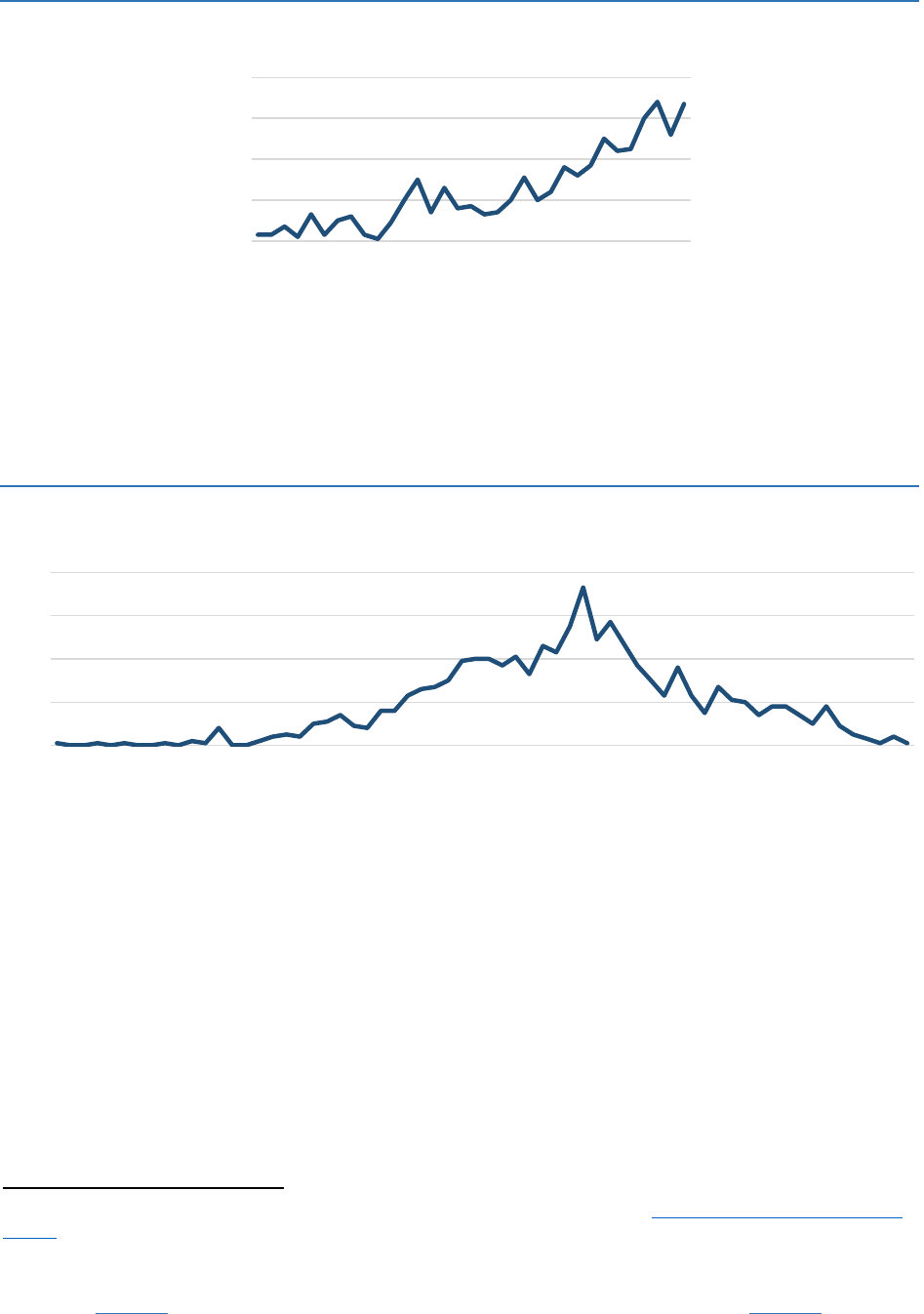
Race and Wrongful Convictions
Page 10 • National Registry of Exonerations • September 2022
Figure 1: Number of Murder Exonerations by Year of Exoneration
In order to study the process that led to an innocent defendant’s conviction, however, we need
to focus on the period leading up to that event, and classify exonerations by date of conviction.
Figure 2 displays the number of murder exonerations by the year in which the exonerees were
convicted. It shows that dates of conviction are more spread out than dates of exoneration; they
range from 1956 to 2019, and rise to a sharp peak from 1992 to 1998.
Figure 2: Number of Murder Exonerations by Year of Conviction
A major reason for the drop off in exonerations for convictions after the mid-1990s is the time
lag from conviction to exoneration, which averages 16.2 years for murder exonerations. As a
result, many exonerations that will eventually happen for murder convictions after 1995 have
not yet occurred, including some in cases that are already more than 25 years after conviction.
It’s likely, however, that even when all those murder exonerations are recorded, there will be a
peak for convictions in the mid-1990s because the all-time high-water mark in the number of
murders in the United States lasted from 1990 to 1994, with convictions trailing by one to a few
years.
21
If we separate out homicide exonerations by race of defendant, we see more Black murder
exonerees than white for all but a handful of years of conviction, despite the fact the Black
people are a small minority of the population. This disparity is concentrated—and accounts for
21
For a useful compilation of FBI crime statistics by year, see The Disaster Center, Unites States Crime Rates 1960
– 2019.
10
30
50
70
90
1989
1991
1993
1995
1997
1999
2001
2003
2005
2007
2009
2011
2013
2015
2017
2019
2021
0
20
40
60
80
1956
1958
1960
1962
1964
1966
1968
1970
1972
1974
1976
1978
1980
1982
1984
1986
1988
1990
1992
1994
1996
1998
2000
2002
2004
2006
2008
2010
2012
2014
2016
2018
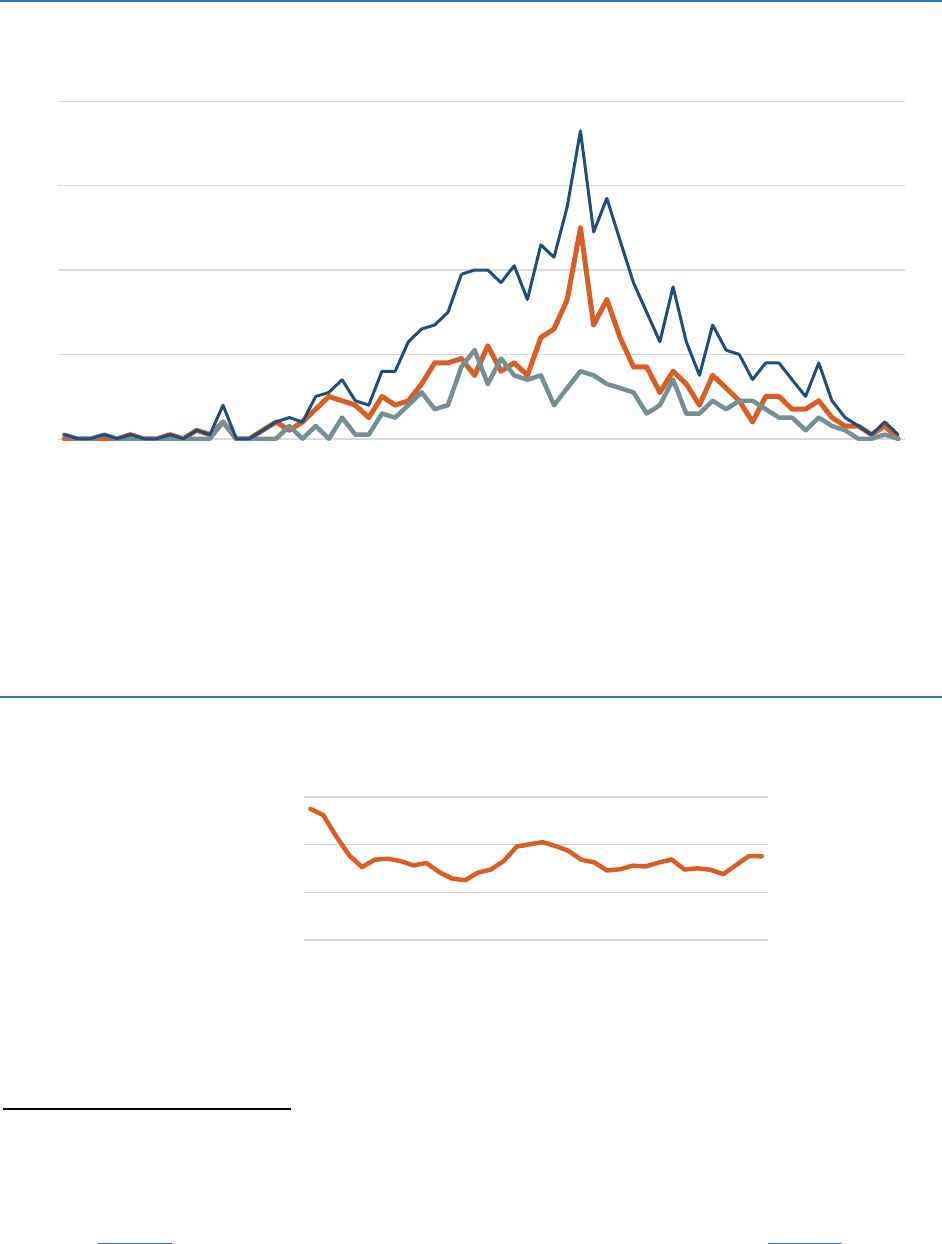
Race and Wrongful Convictions
Page 11 • National Registry of Exonerations • September 2022
the largest number of cases—in the period from 1992 through 2000, the years for which the
number of all murder exonerations is highest. See Figure 3.
Figure 3: Number of Murder Exonerations by Year of Conviction and Race of Defendant
Figure 4 displays a running 5-year average of the percent of murder exonerations with Black
exonerees. By year of conviction, this proportion has remained fairly stable since 1980, ranging
back and forth from 45% to 61%, between three-and-a-half and four-and-a-half times the
proportion of Black people in the population.
Figure 4: Percent of Murder Exonerations with Black Defendants by Year of Conviction
(Five-Year Moving Average)
22
22
For each year, the value of the “Five-Year Moving Average” in Figure 4 is the average of the values for that year,
the two years before and the two years after.
0
20
40
60
80
1956
1958
1960
1962
1964
1966
1968
1970
1972
1974
1976
1978
1980
1982
1984
1986
1988
1990
1992
1994
1996
1998
2000
2002
2004
2006
2008
2010
2012
2014
2016
2018
All
Black
White
20.0
40.0
60.0
80.0
1977
1979
1981
1983
1985
1987
1989
1991
1993
1995
1997
1999
2001
2003
2005
2007
2009
2011
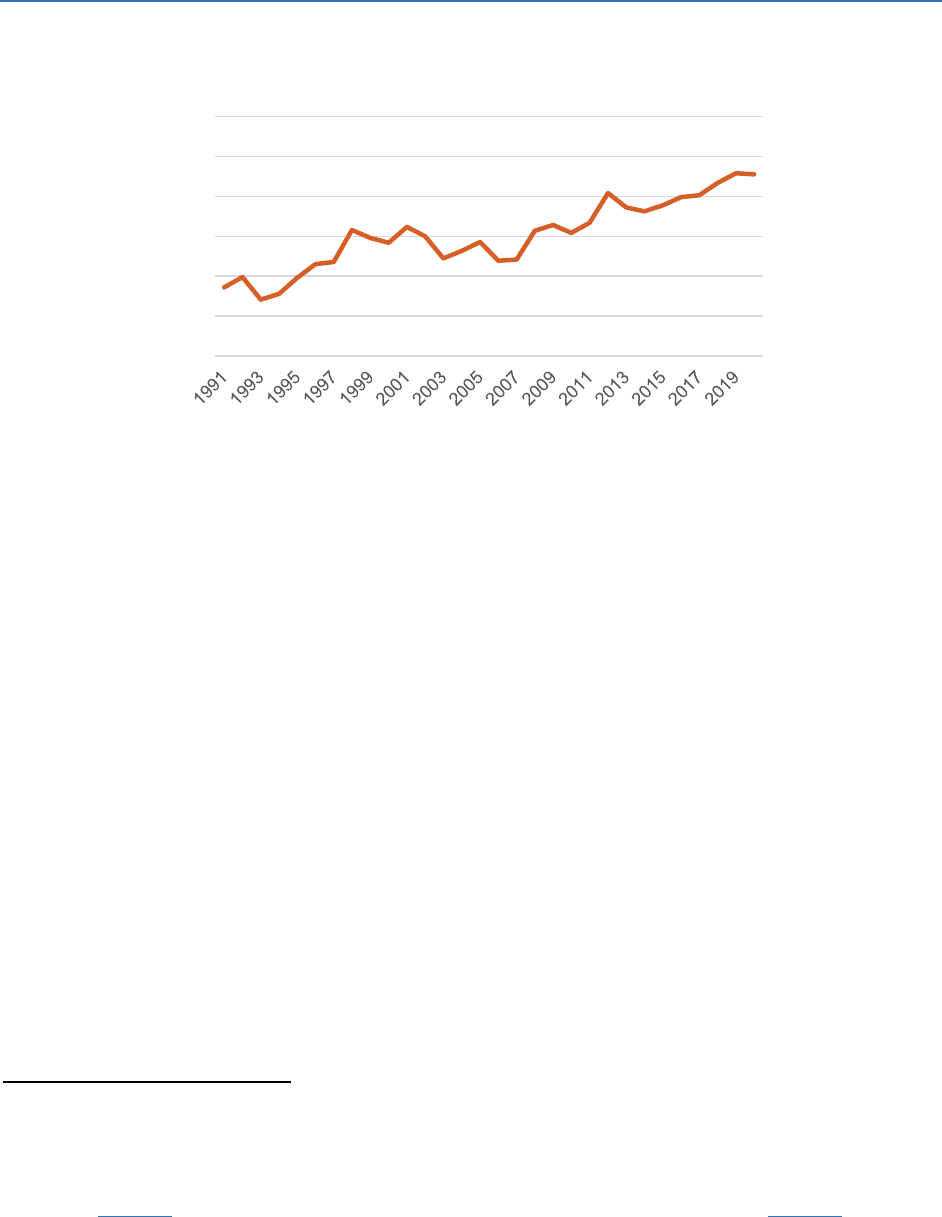
Race and Wrongful Convictions
Page 12 • National Registry of Exonerations • September 2022
On the other hand, there has been a large and reasonably steady increase in the proportion of
Black murder exonerees by year of exoneration, from 37% in 1991 to 66% in 2020, as we see in
Figure 5.
Figure 5: Percent of Murder Exonerations with Black Defendants by Year of Exoneration
(Five-Year Moving Average)
23
Why has there been a sharp increase in the percentage of Black murder exonerees by year of
exoneration since 1991 (Figure 5), while the percentage of Black murder exonerees by year of
conviction remained roughly steady (Figure 4)? The answer turns on two other patterns. First,
as we saw in the previous section, Black murder exonerees spend on average three years longer
in prison before exoneration than white murder exonerees. Second, as we see in Figure 6, the
average time spent in prison for all murder exonerees nearly tripled over the same period, from
less than 7 years for those cleared in 1991 to 19 years for those exonerated in 2019.
23
For each year, the value of the “Five-Year Moving Average” in Figure 5 is the average of the values for that year,
the two years before and the two years after.
20.0
30.0
40.0
50.0
60.0
70.0
80.0

Race and Wrongful Convictions
Page 13 • National Registry of Exonerations • September 2022
Figure 6: Years in Prison before Murder Exonerations by Year of Exoneration (Five-Year
Moving Average)
24
The rate of exonerating innocent murder defendants has picked up steam in spurts since 1989,
rising from about 16 a year through 1993, to 69 murder exonerations a year for the most recent
five-year period. See Figure 1. Along the way, it seems that many of those who worked on these
exonerations—innocence organizations, defense attorneys, prosecutors, judges—began to focus
attention on innocent murder defendants who remained in prison and had been there the
longest.
This process would have occurred at different times in different offices, courts and counties. In
many, probably most, it will happen—if ever—in years to come. But whenever it happens, in
most large American counties, the great majority of the innocent murder defendants who are
identified will be Black prisoners who’ve been ignored for 10, 20, 30 years, or longer. As they are
exonerated, the proportion of Black murder exonerees will rise—as will the average time from
conviction to exoneration. How could it be otherwise? Innocent Black defendants are not only
more likely to be convicted of murder than innocent white defendants, they also receive harsher
sentences and were less likely to be exonerated in early years after conviction.
Many of the innocent Black murder defendants who spent decades in prison were exonerated by
Conviction Integrity Units (CIUs), divisions of prosecutorial offices whose mission is to prevent,
identify, and correct false convictions.
25
The first CIU was founded in 2002 and did little. As of
2007, there were two CIUs in the country; they had been involved in three exonerations. And
then the numbers began to climb exponentially—literally—doubling every few years. By the end
of 2012 there were 9 CIUs across the country; in 2015 there were 24; in 2018, 44; at the end of
2021, 93.
The number of CIU exonerations has followed a similar pattern. From 2008 through 2013, there
were 42 CIU exonerations, an average of 7 a year. In 2014 alone there were 51 CIU exonerations.
24
For each year, the value of the “Five-Year Moving Average” in Figure 6 is the average of the values for that year,
the two years before and the two years after.
25
The National Registry of Exonerations, Conviction Integrity Units.
0.0
5.0
10.0
15.0
20.0

Race and Wrongful Convictions
Page 14 • National Registry of Exonerations • September 2022
From 2015 through 2021, there were 441 CIU exonerations, an average of 63 a year, 37% of all
exonerations in that period (441/1,200).
Since the beginning of 2014, when CIU exonerations became common, CIUs have been involved
in about a third of all murder exonerations (170/538). Sixty-three percent of all murder
exonerees in this period are Black (337/538), compared to 52% for the eight years from 2006
through 2013 (141/270)—in line with the upward trend we see in Figure 5. But only 54% of non-
CIU murder exonerations since 2014 had Black defendants (199/368), compared to 81% of CIU
murder exonerations (138/170). In other words, almost all of the increase in the proportion of
Black murder exonerees in the last eight years is due to the extraordinary concentration of Black
exonerees in CIU murder exonerations. The CIU murder exonerees in this period spent more
time in prison before exoneration, about 21 years on average, compared to 17 for non-CIU
murder exonerees.
Have CIUs been addressing a backlog of innocent Black murder defendants from decades past?
Some clearly have. For example:
In 1988, Curtis Crosland, a 23 year-old Black man, was convicted of murder in
Philadelphia for shooting a grocery store owner during a robbery. He was
sentenced to life in prison without the possibility of parole. Crosland’s conviction
was based primarily on evidence that a witness, who refused to testify at trial, had
testified at a preliminary hearing that he heard Crosland admit that he shot the
store owner. That conviction was reversed on appeal, but Crosland was convicted
again in 1991 based on similar evidence, except that at the second trial the main
witness did testify and explicitly recanted his earlier testimony at the preliminary
hearing.
Over the next 29 years, Crosland and various attorneys working with him
petitioned state and federal courts many times to reopen his case. Along the way,
they obtained statements from three witnesses who had not testified at trial—one
who was in the store and two who were at a window across the street —who did
not see Crosland but did identify other men who were at the scene with guns. All
of those petitions were rejected.
In 2018, Larry Krasner took office as District Attorney of Philadelphia. In his
election campaign, he promised to invigorate the county’s Conviction Integrity
Unit, which until then had participated in three exonerations over a period of
four years. In 2020, a much more active Philadelphia CIU agreed to review the
Crosland case. They found a trove of previously concealed evidence, including
documents that show that the main witness against Crosland had lied about that
case and other matters on many occasions; and that a man who had been seen at
the robbery by the witnesses who were found by Crosland’s post-conviction
attorneys had also been identified to the police as the shooter repeatedly, in the
initial investigation in 1988.
In late May 2021, in a proceeding in federal court, the Philadelphia District
Attorney’s Conviction Integrity Unit agreed that Crosland’s conviction should be
vacated because the trial prosecutors “violated Crosland’s right to due process by
not disclosing this evidence to him prior to trial, resulting in his wrongful

Race and Wrongful Convictions
Page 15 • National Registry of Exonerations • September 2022
conviction.” In June 2021, charges were dismissed, and Crosland was released
after 33 years in prison.
Curtis Crosland is the twenty-second of 25 CIU murder exonerees in Philadelphia since 2014
26
—
92% of whom are Black. That number is highly unusual. Most CIUs have had no exonerations at
all so far (53/94), including at least nine units that opened five years ago or longer; many others
have been involved in only one or two exonerations.
27
The 138 Black CIU murder exonerees since 2014 are spread across 26 different CIUs, but not
evenly. Almost four-fifths (108/138)—including a third of all Black murder exonerees in the
United States in this period—come from CIUs in eight counties, all in large East Coast or
Midwestern cities: Philadelphia (23), Brooklyn (19), Detroit (19), Chicago (17), Baltimore (13),
Boston (7), Queens (6) and the Bronx (4).
28
There’s no reason to think this trend will slow down
in those cities, and as more CIUs become active the pace may accelerate.
In sum: We know how many exonerated murder defendants are Black—55%—but we don’t know
the percentage of Black people among all falsely convicted murder defendants. We also know
that Black murder exonerees spend longer in prison before exoneration than whites, which
means that when the rate of exonerations is rising, as it has been since 1989, innocent Black
defendants may be underrepresented among those who have been exonerated. Since the
beginning of 2014, the number of murder exonerees who spent 20, 30 or even 40 years in prison
has grown, and the proportion of murder exonerees who are Black has increased substantially. A
handful of big-city CIUs are responsible for most of that increase. Without them, 56% of murder
exonerees since the beginning of 2014 would have been Black; with them, it’s 64%.
d) Intentional and structural discrimination
In some cases, it’s easy to spot racism in the investigations or the prosecutions that led to the
false murder convictions we study:
In 1980, a Texas Ranger investigating the rape-murder of a high school student
described what was coming to the two custodians who found the body, Clarence
Brandley and a white colleague. He said, “One of you is going to have to hang for
this” and, turning to Brandley, added, “Since you’re the nigger, you’re elected.”
Brandley was sentenced to death in 1981 and exonerated in 1990.
In 1987, in Monroeville, Alabama, police framed Walter McMillian for the
murder of a clerk at a dry cleaner’s. McMillian, a 46-year old Black man, had
numerous alibi witnesses, all Black: he was at a fish fry at the time of the killing.
But he also had a white girlfriend, which was reason enough for the police to
target him. McMillian was sentenced to death in 1988 and exonerated in 1993.
More often, discrimination is less overt:
In 2014, Glenn Ford was exonerated after 30 years on death row in Louisiana. He
was released because over the decades after his conviction, his lawyers discovered
26
All but one were obtained after Larry Krasner became the District Attorney in 2018.
27
The National Registry of Exonerations, Conviction Integrity Units.
28
The counties are: Baltimore City, Maryland; Bronx, New York; Cook (Chicago), Illinois; Kings (Brooklyn), New
York; Philadelphia, Pennsylvania; Queens, New York; Suffolk (Boston), Massachusetts; Wayne (Detroit), Michigan.

Race and Wrongful Convictions
Page 16 • National Registry of Exonerations • September 2022
several facts that undermined the state’s case: trial testimony by the state’s expert
witnesses was false or misleading; police officers lied to the jury about what Ford
said to them; hidden police reports included tips from informants that implicated
two other suspects, but not Ford; and one of those two suspects admitted that he
was the actual killer.
In 2015, A.M. “Marty” Stroud III, the former trial prosecutor who put Ford on
death row in 1984, published a remarkable apology: “Glenn Ford was an innocent
man. He was released from the hell hole he had endured for the last three
decades.”
29
Stroud takes painful personal responsibility for the tragedy, but not because of
deliberate misconduct. He was inattentive: “My fault was that I was too passive. I
did not consider the rumors about the involvement of parties other than Mr. Ford
to be credible…. Had I been more inquisitive, perhaps the evidence would have
come to light years ago.”
Stroud describes how he played by rules that gave him an unfair advantage over
an innocent man: “I did not question the unfairness of Mr. Ford having
appointed counsel who had never tried a criminal jury case much less a capital
one.” Even more troubling: “The jury was all white, Mr. Ford was African-
American. Potential African-American jurors were struck with little thought
about potential discrimination because at that time a claim of racial
discrimination in the selection of jurors could not be successful….”
30
Stroud is unsparingly self-critical, but he does not describe himself as racist: “In
1984, I was 33 years old. I was arrogant, judgmental, narcissistic and very full of
myself. I was not as interested in justice as I was in winning.” He believed Ford
was guilty and did not question that belief. The same is probably true of the
police officers who concealed information about the real killers, the judge who
presided over the selection of an all-white jury, and the jury itself, which
sentenced Ford to death.
Some police and prosecutors may habitually assume that any Black murder suspect they deal
with is a killer. That’s false, of course, and it’s a form of racial profiling. If they are white, they
may mistrust claims of innocence by Black defendants and alibi evidence from Black witnesses
because Black people are unfamiliar to them and seem less trustworthy than those who are more
similar to themselves.
All of us—including judges and jurors as well as lawyers and police—are subject to unconscious
racial biases—and all of us are prone to go along with accepted practices. Routine, institutional
discrimination is more common than intentional racism, and probably harder to detect and
29
Stroud III, A.M. “Marty”. Lead Prosecutor Apologizes for Role in Sending Man to Death Row. Shreveport Times.
March 2015.
30
Ford was convicted two years before the landmark case of Batson v. Kentucky, 476 U.S. 79 (1986), in which the
Supreme Court for the first time created a procedure for challenging the use of peremptory challenges to create all-
white criminal trial juries.

Race and Wrongful Convictions
Page 17 • National Registry of Exonerations • September 2022
correct. Perhaps that is one reason why Clarence Brandley, the target of explicit racism, was
exonerated nine years after he was convicted, while Glenn Ford had to wait 30 years.
Would Glenn Ford have been convicted and sentenced to death if he had not been a Black man
charged with killing a white victim? There’s no way to know. Hundreds of white defendants have
also been falsely convicted of murder, and most of their cases included serious official
misconduct. But we do know that innocent Black murder defendants as a group are at a
disadvantage because of their race, and that sometimes it costs them their freedom, and most or
all of their remaining years.
3. The net effect
We don’t know the number of false criminal convictions, for murder or any other crime. Most by
far remain hidden—false convictions far outnumber exonerations—and we have too little
information to estimate that hidden figure.
31
Except in one context: death sentences.
Death sentences have a far higher rate of exoneration than other criminal convictions, and we
have far more detailed data on them than any other category of criminal sentences. A study
published in the Proceedings of the National Academy of Sciences made use of these unique
characteristics to calculate “a conservative estimate of the proportion of false convictions among
death sentences in the United States”—4.1%.
32
As the study is careful to point out, this estimate is for death sentences only. It cannot be applied
to all crimes, or even to all murders. Still, it’s a starting point; it suggests that the rate of
miscarriages of justice for murders in general is somewhere in the general vicinity of the rate for
capital murders.
Assume for a moment that the proportion of innocent defendants among all murder convictions
is half the rate for death sentences, 2%. That would mean there would be about 3,300 innocent
defendants among the estimated 165,000 inmates who are in American prisons for murder
convictions,
33
plus thousands more among the comparable number of defendants who were
convicted of murder in the past 40 years but are not now in prison because they were released or
have died.
In short, it’s likely that at least several thousand defendants have been falsely convicted of
murder in the time period covered by the Registry, and—judging from the exonerations we have
seen—more than half of them were Black.
31
Gross, Samuel R. What We Think, What We Know, and What We Think We Know About False Convictions. Ohio
State J. of Crim Law, Vol. 14, No. 2 (Spring 2017), at pp. 765-67.
32
Gross, Samuel R., O’Brien, Barbara, Hu, Chen and Kennedy, Edward. Rate of False Conviction of Criminal
Defendants Who Are Sentenced to Death. Proceedings of the National Academy of Sciences, Vol. 111, No. 20 (May
20, 2014); pp. 7230-7235.
33
As of the end of 2019. E. A. Carson, Prisoners in 2020 - Statistical Tables. Bureau of Justice Statistics, U.S. Dep’t
of Justice (December 2021). Calculated from Tables 15 and 18, pp. 29, 33.

Race and Wrongful Convictions
Page 18 • National Registry of Exonerations • September 2022
III. Sexual Assault
Nearly 60% of rape exonerations involve Black people, who are the defendants in less
than a quarter of rape convictions. The majority of rape exonerees were misidentified
by victims who had been raped by strangers. Two thirds of those misidentified rape
defendants were Black men, most of whom were misidentified by white victims.
Cross-racial eyewitness identification is a notoriously risky process. It appears
to be the leading cause of rape convictions of innocent Black men in the United
States. But it’s not the only factor. Some of the misidentifications were obtained
by deliberately tainted identification procedures, and Black men are also
overrepresented in the minority of rape exonerations without
misidentifications. In addition, Black rape exonerees received longer sentences
than whites, and spent several more years in prison before release.
This country has a horrific history of racism in addressing accusations of inter-
racial rape against Black men. The persistence of that racism is easy to spot in
some rape exonerations. In others, no doubt, it’s hidden beneath the surface.
Most rape exonerations are based on post-conviction DNA evidence that proves
that the exoneree was not the rapist. Such exonerations became increasingly
uncommon as DNA testing became widely available to determine the identity of
rapists before trial. There have been no DNA rape exonerations for convictions
after 2007: DNA testing has greatly reduced false convictions based on
mistakes about the identity of rapists. This is a major achievement. It has
prevented the conviction of hundreds if not thousands of innocent rape suspects,
mostly Black men who were accused of raping white women.
1. Race and false conviction for rape
Fifty-nine percent of sexual assault exonerees are Black, four-and-a-half times the proportion in
the population; 33% are white. That suggests that innocent Black people are almost eight times
more likely than white people to be falsely convicted of rape. Unlike murder, these numbers are
way out of line with the racial composition of sexual assault convictions. As of the end of 2019,
21% of those serving time in state prisons for sexual assault were Black, 39% were white, and
25% Hispanic.
34
Judging from known erroneous convictions, a prisoner serving time for sexual
assault is more than three times more likely to be innocent if he is Black than if he is white.
34
Id. (the remaining 15% were Indigenous People; Asians, and Pacific Islanders; and persons of two or more races).

Race and Wrongful Convictions
Page 19 • National Registry of Exonerations • September 2022
2. Eyewitness misidentification
The leading cause of false sexual assault convictions is eyewitness misidentification of
defendants who are strangers to the victims.
Ninety-eight percent of sexual assault exonerations have female victims. Strangers commit only
about a quarter of rapes in the United States,
35
but they account for 69% of the false rape
convictions that result in exoneration (243/350).
In 75% of sexual assault exonerations, the identity of the man who committed the rape was the
central issue at trial (263/350); 87% of those cases were rapes by strangers (228/263), and 89%
included mistaken eyewitness identifications (233/263). In the remaining 25% of sexual assault
exonerations the assault never happened (87/350). Instead, the supposed victim lied about a
consensual sexual encounter or fabricated an attack from scratch. None of these “no-crime”
exonerations involved mistaken eyewitness identifications; in 83% the complainant knew the
innocent defendant (72/87).
There were eyewitness misidentifications in 67% of all sexual assault exonerations (233/350),
including 84% of the cases in which the defendants were strangers to the victims (205/243). The
rate of eyewitness errors is much higher for innocent Black defendants—74% (154/207)—than
for white defendants, 53% (61/116).
In 44% of all sexual assault exonerations with eyewitness misidentifications, Black men were
convicted of raping white women,
36
a racial combination that appears in less than 11% of sexual
assaults in the United States.
37
According to surveys of crime victims, about 70% of white sexual
assault victims were attacked by white men and only about 13% by Black men.
38
But 52% of
sexual assault exonerees with white female victims are Black (129/49), and 43% are white
(106/249)—which suggests that Black defendants convicted of raping white women are more
than six times more likely to be innocent than white men convicted of raping women of their
own race.
There are many possible explanations for this disturbing pattern, but the simplest is probably
the most powerful: the perils of cross-racial identification. One of the oldest and most consistent
findings of systematic studies of eyewitness identification is that white Americans are much
more likely to mistake one Black person for another than to mistakenly identify members of
their own race.
39
35
See, e.g., Bureau of Justice Statistics, U.S. Dep’t of Justice, Criminal Victimization in the United States, 2008,
Statistical Tables, Table 27.
36
To be precise, this ratio is the number of sexual assault exonerations with mistaken eyewitness identification, and
with Black defendants and white victims, divided by the number of all sexual assault exonerations with mistaken
eyewitness identification in cases in which the races of the defendants and all the victims are known (101/229).
37
Black offenders accounted for an average of approximately 11% of all rapes and sexual assaults of white victims
from 1996 through 2008. Bureau of Justice Statistics, U.S. Dep’t of Justice. Criminal Victimization in the United
States, 1996-2008 (based on the National Criminal Victimization Survey; the statistic fluctuates because for each
year it is usually extrapolated from a sample of ten or fewer survey responses).
38
Id.
39
See Meissner, Christian A. and John C. Brigham. “Thirty Years of Investigating the Own-Race Bias in Memory for
Faces: A Meta-Analytic Review.” 7 Psychol., Pub. Pol’y & L. 3 (2001).

Race and Wrongful Convictions
Page 20 • National Registry of Exonerations • September 2022
The problem of cross-racial identification in rape prosecutions in America is asymmetrical. It
poses a greater risk of misidentification for Black sexual assault defendants than for white
defendants, for two reasons. First, a lower proportion of sexual assaults by white perpetrators
are cross-racial. Most sexual assault victims are friends, family members or acquaintances of the
attackers, who are likely to be of the same race—and if the victim is a stranger, she is likely to be
white regardless of the race of the attacker simply because whites are the great majority of the
population. Second, in experimental studies, white subjects show stronger “own race bias” than
Black subjects—they tend to be worse at identifying members of other races. This is not
surprising. As members of the majority group, many white Americans have little contact with
Black people, but almost all Black people have regular dealings with white people.
40
3. Misconduct and discrimination
a) Tainted identifications
Eyewitness misidentifications do not occur in a vacuum. Some are the products of misconduct
and racial bias.
Marvin Anderson was suspected of rape in Virginia because the real rapist told
his victim that he “had a white girl,” and Anderson was the only Black man
known to the local police who lived with a white woman. Anderson had no
criminal record, so an officer showed his color employment identification photo
to the victim together with half a dozen black-and white mug shots of other men,
and asked her to pick the perpetrator. Naturally, she chose Anderson, who spent
15 years in prison before he was exonerated by DNA.
Anderson’s false conviction was the product of a tainted identification, a dangerous form of
misconduct in which police, directly or (as in this case) indirectly, tell an eyewitness who to pick
in a formal identification procedure.
Tainted identifications occurred in 10% of the investigations of defendants who were convicted
of rape and later exonerated (35/350). That’s about the same rate we saw for murder
exonerations (112/1,167), but the process was quite different.
In murder cases, about 40% of tainted identification threats were used to induce the witnesses
to identify the defendants—usually threats of arrest or prosecution (44/112). Predictably, that
happened in nearly half of tainted murder identifications of Black exonerees (36/75), but only
11% of the few tainted identifications of white murder defendants (2/18).
In sexual assault exonerations the victims always survive the crimes, by definition, because if a
victim is killed, the case becomes a murder. Unlike murder prosecutions, the critical eyewitness
in a sexual assault case is almost always the victim. Perhaps for that reason, none of the tainted
identifications in sexual assault exonerations include threats by the police.
41
Instead, as in
40
Id. at p.18.
41
In a few exonerations that included sexual assaults as well as other violent crimes, police threatened witnesses
other than the rape victims and forced them to identify the exonerees. Samuel Gross, et al., Government Misconduct
and Convicting the Innocent, National Registry of Exonerations (2020) at p. 41 n. 67.

Race and Wrongful Convictions
Page 21 • National Registry of Exonerations • September 2022
Marvin Anderson’s case, they may draw attention to the person they suspect without saying so.
For example:
Thomas Doswell was identified by a rape victim in Pittsburgh who was shown
photographs of eight men, one of which—Thomas’s—had the letter "R" (for rapist)
written on it. He was exonerated by DNA 19 years later.
In other cases, the authorities are more straightforward. After a rape victim picked the man
standing next to Anthony Broadwater in a lineup in Syracuse, New York, in 1981, the prosecutor
told her: “Of course you chose the wrong one… He and his attorney worked to make sure you’d
never have a chance…. [He] had his friend come down and stand next to him. We had to send a
car to the prison to get him here. They wouldn’t go ahead until he showed…. They totally worked
a number on you. He uses that friend, or that friend uses him, in every lineup they do. They’re
dead ringers.” Every part of the prosecutor’s statement was false. After the victim identified him
at trial, Broadwater spent sixteen-and-a-half years in prison and 21 years as a registered sex
offender before he was exonerated in 2021.
And in Jerry Lee Evans’s case, Dallas police simply told the victim which picture to choose. He
spent 22 years in prison before he was exonerated and released.
In three quarters of murder exonerations with tainted identifications, one or more eyewitnesses
lied and deliberately misidentified the exoneree (84/112), usually in cases in which they were
threatened (44/84). In the absence of threats, only two rape exonerations with tainted
identifications include deliberate misidentifications of the defendants.
The rate of tainted identifications is only slightly higher among Black rape exonerees than
among whites, 11% to 9%. Still, as usual, Black rape exonerees who were set up for these
misidentifications outnumber whites by more than two to one (22 to 10), and nearly half of all
tainted identifications in rape exonerations are Black exonerees who were misidentified by white
victims.
b) Rape exonerations without eyewitness misidentifications
In a third of rape exonerations there were no mistaken eyewitness identifications (117/350).
Nonetheless, 45% of the exonerees in those cases are Black—less than the rate for rape
exonerations with misidentifications (69%) but more than twice the proportion of Black people
among those imprisoned for rape and about three and a half times their proportion of the
population.
In three quarters of rape exonerations without misidentifications, no rape was committed
(87/117). Most often, the complainants lied and accused the defendants of rape after consensual
sex; in a few they said they’d been raped to avoid admitting to consensual sex with someone
else; and in a couple of cases the complainants were delusional.
In the remaining quarter of these cases, the victims were raped but for one reason or another
could not identify the rapists, who were convicted by other means (30/117). In most, (16/30) the
conviction depended on a confession from the defendant, or from a co-defendant (guilty or
innocent) who implicated the exoneree as well as himself. Some of these confessions were
obtained by misconduct in racially tainted investigations.

Race and Wrongful Convictions
Page 22 • National Registry of Exonerations • September 2022
In 1983, Stanley Wrice, a Black man, was convicted of participating in a vicious
gang rape of a white woman in Chicago and sentenced to life in prison. The victim
did not identify Wrice, but he had confessed and two witnesses testified that they
saw him participate in the rape. Wrice was exonerated in 2013 after it was
established that he had been tortured into confessing by two officers in a Chicago
police unit that specialized in obtaining confessions by torture, mostly from Black
murder suspects. (Two years earlier, their commander, Lieutenant Jon Burge,
was sent to federal prison for committing perjury in testimony about the unit.) By
then, one of the two supposed eyewitnesses, also a Black man, had recanted and
stated under oath that he too had been tortured, to force him to testify against
Wrice; the other witness had died.
c) Racism and discrimination
Racism in rape prosecutions can become a self-fulfilling prophecy—and an excuse for
misconduct. In some cases, the critical players are defense attorneys, judges or jurors, rather
than prosecutors or police officers.
In 1990, Michael Phillips, a Black man, pled guilty in Dallas to the rape of a 16-
year old white girl who misidentified him. Phillips later said that his lawyer never
investigated his unanswerable claim that he was physically incapable of
committing the crime; instead, she persuaded him that he would get life in prison
if he went to trial because no jury would believe a Black man over a white girl.
Phillips spent 12 years in prison, an unusually long term for a rape by a defendant
with no prior record for violence or sexual misconduct. He was exonerated in
2014 when the rape kit was finally tested for DNA.
In some cases, the presence of racism is unmistakable.
In 1991, Marcus Lyons had recently been released from prison after completing a
sentence for rape. He tried to call attention to his case by putting on his Navy
uniform, going to the steps of the DuPage County, Illinois, courthouse, and
nailing his foot to a cross made out of railroad ties. One of the officers who
stopped him said “Come on nigger, your 15 minutes of fame are over.” Lyons was
exonerated in 2007, by DNA testing of semen found on underpants worn by the
victim. He might have been cleared in 1988 if blood-type testing had been done
on those underpants, but the police—who knew the pants had never been tested—
let the lawyers believe they had been and no semen was found.
In others, the impact of race is a shade less explicit.
In 1984, Ulysses Charles, a Black immigrant from Trinidad who spoke with a
strong Caribbean accent, was convicted of raping three white women in Boston.
All three victims misidentified Charles as the rapist, even though they had told
police that the rapist had an American accent, and had failed to mention
Charles’s dreadlocks and gold front teeth. Before trial, tests on crime scene
evidence found seminal fluid from the rapist and showed that the attacker had
blood type O; Charles, as the police knew, had blood type B. That evidence was
concealed, and at trial the prosecutor called a forensic analyst who testified

Race and Wrongful Convictions
Page 23 • National Registry of Exonerations • September 2022
falsely that the rapist had not ejaculated. Charles was exonerated by DNA testing
in 2001, after 20 years in prison.
Would the extreme misconduct that sent Charles to prison have occurred if he had been white?
Would the victims have been confident of their identifications, despite the fact that he did not
resemble the man they had earlier described? Would the jurors? Maybe—but it seems unlikely.
Of all the problems that plague the American criminal justice, few if any are as incendiary as the
relationship between rape and race. From the Reconstruction through the first half of the
twentieth century, claims that Black men raped white women triggered countless lynchings,
riots and sometimes massacres of Black people.
42
Those horrors have stopped, but the fears and
biases that fed them have not disappeared. It should be no surprise that racial bias and outright
racism also play a role in wrongful convictions for sexual assault.
4. Sentencing and time in prison before exoneration
On average, Black sexual assault exonerees spent more than four years longer in prison than
white sexual assault exonerees, 13.5 years compared to 9.4 years. Much of this disparity is
caused by a comparatively small number of exonerees who were imprisoned for decades. Thirty-
five sexual assault exonerees spent 25 years in prison or longer; half of them were exonerated in
the past nine years. Of those, one was Hispanic, six were white—and 28 were Black, 80% of the
total, including all but one of the nine who were imprisoned for 30 to 45 years.
Black sexual assault exonerees also received harsher sentences than whites: 27% were sentenced
to life imprisonment (55/207) compared to 17% for white sexual assault exonerees (20/116); of
the rest, 17% of Black rape exonerees were sentenced to 45 years or longer (36/207), compared
to 7% of whites (8/116); and the average minimum term for those who were not sentenced to life
was 26 years for Black defendants and 18 years for white defendants.
These are extremely severe sentences, by any measure, for white and Black sexual assault
exonerees alike. In 2000, for example, only 1.6% of all sexual assault defendants convicted in
state courts were sentenced to life imprisonment, the average maximum term of incarceration
was 7 years, and 16% received probation
43
(as did three of 349 sexual assault exonerees, less
than 1%). Part of the explanation is the process that produced these sentences. Eighty-eight
percent of sexual assault convictions in state courts in 2000 were based on guilty pleas, almost
all pursuant to plea bargains, but 92% of sexual assault exonerees went to trial (321/349). From
the look of it, they paid heavily for their day in court—especially the Blacks. Very likely, many
innocent defendants who have not been exonerated decided not to take that risk.
Our data are limited. We have only sketchy information on racial patterns in sentencing for
sexual assault convictions in general, none for those with innocent defendants who were not
exonerated, and incomplete data on the details of the crimes and the process of obtaining
exonerations even for the cases we know best, those that we list in the Registry.
We cannot say for sure why so many Black sexual assault exonerees received such extreme
sentences, even by comparison to the draconian sentences meted out to white sexual assault
42
See, e.g., Gilbert King, Devil in the Grove: Thurgood Marshall, the Groveland Boys, and the Dawn of a New
America, 2012; Yuliya Parshina-Kottas, et al., What the Tulsa Race Massacre Destroyed, N.Y. Times, May 24, 2021.
43
Bureau of Justice Statistics, U.S. Dep’t of Justice. Felony Sentences in State Courts. (2000)
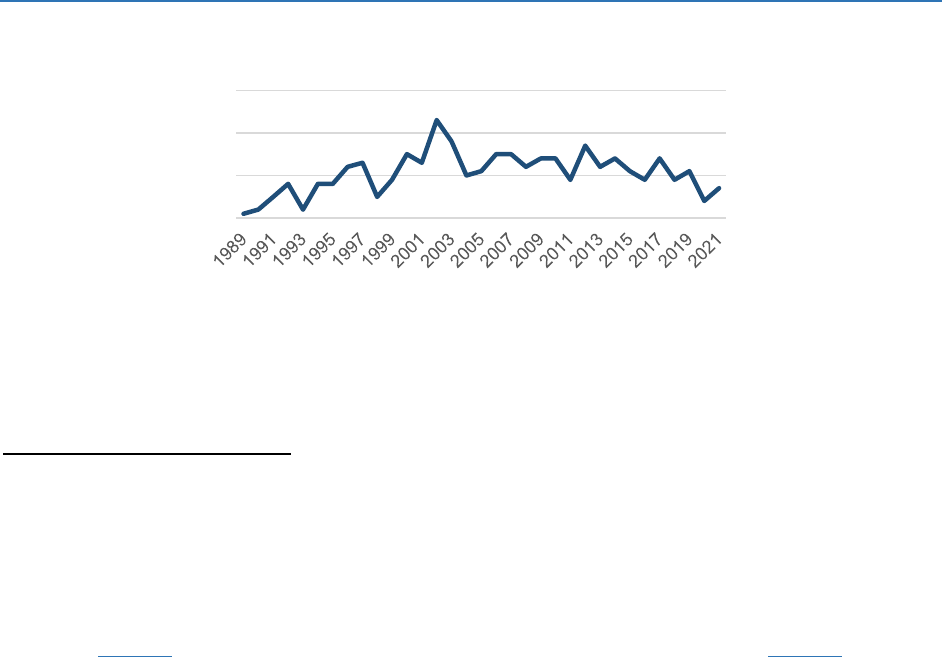
Race and Wrongful Convictions
Page 24 • National Registry of Exonerations • September 2022
defendants who were later exonerated. Differences in criminal history cannot explain the gap:
Among sexual assault exonerees who had no prior criminal convictions, the only four who
received life sentences were Black. The average term for the rest was 24 years for Black
exonerees and 11 years for white exonerees. Our best guess is that Black sexual assault
defendants who insisted on their innocence and refused to plead guilty were punished more
harshly for doing so than innocent white defendants who followed the same course.
Sentence length has an obvious impact on the time exonerated defendants spend in prison: the
longer the sentence, the longer the time it is possible for the defendant to spend in prison before
exoneration. That explains some of the racial difference in prison time before exoneration for
sexual assault, but not all. Controlling for length of sentence, Black sexual assault exonerees
served on average about three years longer before release than white exonerees.
44
In short, we don’t know why Black sexual assault exonerees spent so much more time in prison
before release than white sexual assault exonerees, but there are two simple, plausible and
compatible explanations: they received longer sentences when convicted, and they faced greater
resistance to exoneration, even in cases in which they were ultimately released.
5. Changes over time
Rape exonerations are decreasing. Across the time span of the Registry, murder exonerations
increased by a factor of five, from 14 a year in 1989-1992 to almost 72 a year in 2018-2021, as we
saw in Figure 1. Rape exonerations also rose in the first dozen years of the Registry, from a few a
year in 1989-1990 to a peak of 23 in 2002—but then fell back to an average of about 13 a year
through 2017, before dropping to less than ten a year in the last few years. See Figure 7.
Figure 7: Number of Sexual Assault Exonerations by Year of Exoneration
The comparison is equally telling when we examine exonerations by the year of the conviction of
the innocent defendants instead of the year in which the exoneration occurred. The peak in
murder exonerations is for convictions in 1995, directly following the all-time record in murders
in the United States, after which the number declines more or less steadily as the convictions
approach the present. See Figure 2. Rape exonerations peaked earlier, for convictions in 1990,
44
We computed the following ordinary least squares regression analysis with Years Lost before exoneration as the
dependent variable, and Sentence in years, Race (1 if defendant is Black; 0 otherwise), and the interaction of
Sentence and Race as the independent variables:
Years lost = 3.962 + 3.163 Black + .244 Sentence - .110 Sentence * Black.
The coefficients for all three independent variables are statistically significant.
0
10
20
30
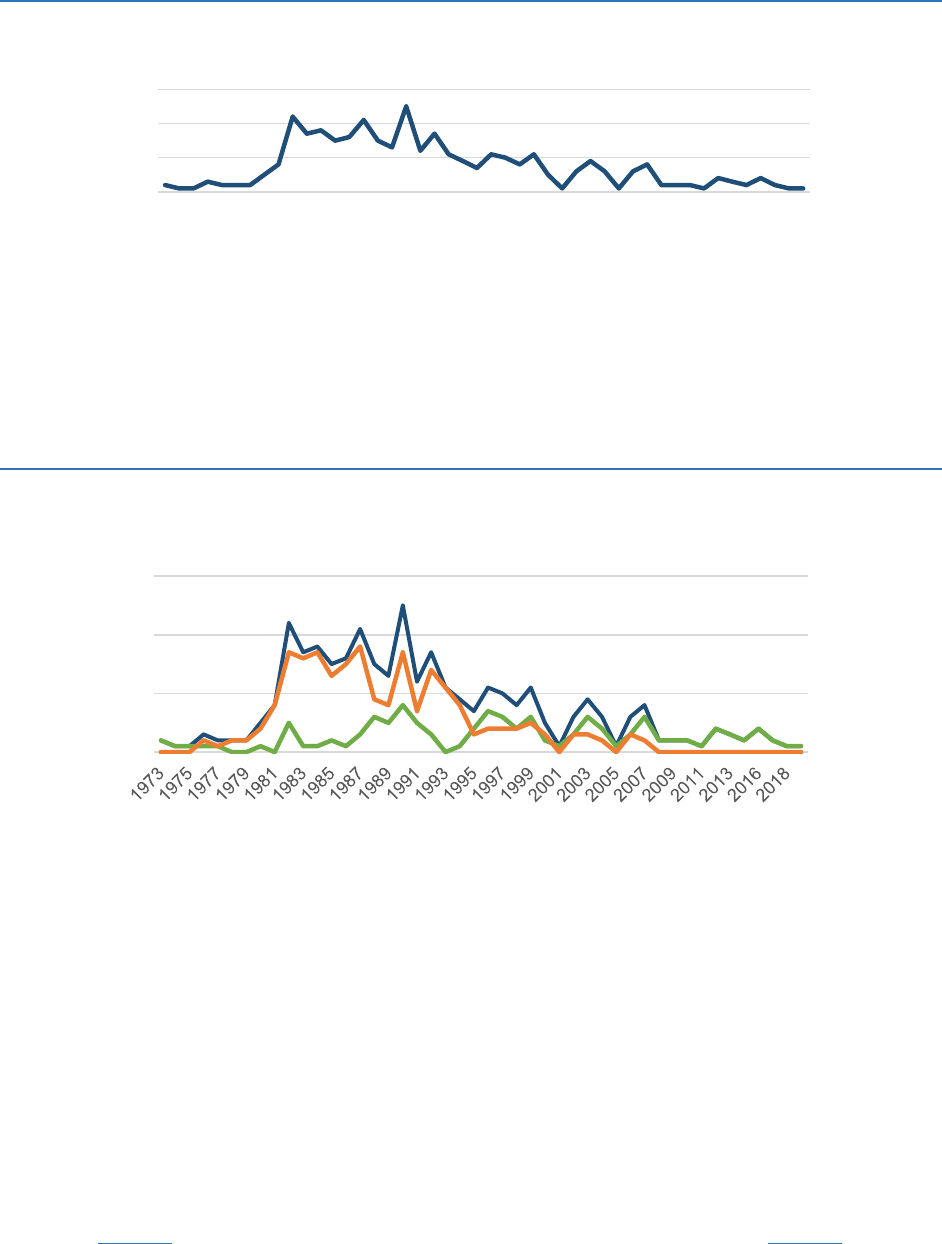
Race and Wrongful Convictions
Page 25 • National Registry of Exonerations • September 2022
then dropped rapidly for a decade, averaging about four a year for convictions from 2001
through 2010, and about two a year since. See Figure 8.
Figure 8: Number of Sexual Assault Exonerations by Year of Conviction
The cause of this pattern is no mystery. Two thirds of rape exonerations are for convictions from
1973 through 1994 (237/350); 80% of them were based on post-conviction DNA testing
(189/237). After that, DNA rape exonerations declined for convictions through 2007, and then
disappeared entirely. Non-DNA rape exonerations, by contrast, have occurred at a reasonably
steady low rate for convictions since 1982, averaging about three a year. See Figure 9.
Figure 9: Number of DNA and Non-DNA Sexual Assault Exonerations by Year of
Conviction
DNA testing is extremely effective at identifying a person who left testable biological evidence at
a particular location. Because rapists usually leave semen or other biological material in, on or
near the bodies of their victims, DNA evidence can be uniquely effective for determining
whether a defendant who was convicted of rape was in fact the rapist. That’s the main reason for
the surge of rape exonerations after post-convictions DNA testing became available in the
United States, starting in 1989—225 exonerations to date, 85% of which included eyewitness
misidentifications. DNA testing is no help in determining guilt or innocence in a rape case when
the identity of the person who had sex with the complainant is not an issue, usually because the
only dispute is whether the sex was consensual.
In 1989, when DNA exonerations started, there was a large backlog of erroneous rape
convictions from earlier years, when pre-trial DNA testing was not available. It has produced
0
10
20
30
1973
1975
1977
1979
1981
1983
1985
1987
1989
1991
1993
1995
1997
1999
2001
2003
2005
2007
2009
2011
2013
2016
2018
0
10
20
30
All
DNA
Non DNA

Race and Wrongful Convictions
Page 26 • National Registry of Exonerations • September 2022
132 DNA rape exonerations so far— almost 60% of the total—and new ones from this era
continue to trickle in. After 1989, pre-trial DNA testing became available—over time. In the early
1990s, it often was not done, and quite a few innocent rape defendants who might have been
cleared by DNA were convicted—57 that produced exonerations for convictions from 1990
through 1994, about 11 a year. That rate declined to about three per year from 1995 through
2007, and none at all for rape convictions since 2008.
Judging from exonerations, it appears that for the last 14 years, all (or nearly all) innocent rape
suspects in the United States who might benefit from DNA testing were never convicted because
the DNA evidence cleared them before trial. Unfortunately, a minority of misidentified rape
suspects do not benefit from DNA testing because, for one reason or another, there is no
biological material to test.
There have been 136 exonerations of misidentified rape defendants who were convicted from
1980 through 1989, about 14 a year, but only 12 who were convicted in the ten years from 2000
through 2009—and just two in the twelve years since. It seems that, now that pre-trial DNA
testing is well established in the United States, the number of false rape convictions based on
misidentifications has plummeted.
More than 70% of the innocent rape defendants who were misidentified and convicted in the
1980s were Black men (98/136)—70% of whom were convicted of raping white women (68/98).
Of the handful who were misidentified in the 21 years since 2000, only about a third were Black
(5/14), and just two were convicted of assaulting white victims.
By preventing most false convictions of misidentified rape defendants, DNA testing has
eliminated the bulk of the disproportionate, often discriminatory, and sometimes racist
convictions of innocent Black men who were accused of raping white women. We know that a
dozen or more exonerations a year no longer happen. We don’t know the total number of
convictions of innocent Black rape defendants that are now prevented, but it must be hundreds
a year.
45
45
In the meantime, since 1991, rape exonerations without eyewitness misidentification have continued at a low but
fairly steady pace of about three a year. Fewer than half of the exonerees are Black (37/86), about 40% of them in
cases with white complainants (15/37). See Figure A:
Figure A: Number of Rape Exonerations without Eyewitness Misidentifications, by Year of Conviction
0
5
10
15

Race and Wrongful Convictions
Page 27 • National Registry of Exonerations • September 2022
IV. Drug Crimes
Sixty-nine percent of drug crime exonerees are Black and 16% are white. That
means that innocent Black people are 19 times more likely to be convicted of
drug crimes than innocent white people. By now, this finding may seem
depressingly familiar, but it’s actually much worse than anything we’ve seen—
and probably understates the actual disparity.
White and Black Americans use illegal drugs at similar rates, but Black people
are arrested for drug crimes (overwhelmingly drug possession) at several times
the rate of white people. That’s because essentially none of the huge number of
drug crimes in the United States are reported to the police, so they get to choose
who to investigate, search and arrest for drug crimes, and they usually choose
Black people.
That’s racial profiling—the process by which the War on Drugs is focused on
minorities, especially Black people. Most innocent victims of racial profiling are
stopped and searched, perhaps harassed and humiliated—but not arrested. But
some are arrested and convicted in error, usually because of unreliable field
testing for drugs. For the most part, these are hardly blameless errors: the
victims are Black people who were stopped, searched and subjected to that risk
because of their race.
In addition, we know of 17 groups of defendants who were wrongfully convicted
of drug crimes by systematic police misconduct, including many who were
framed by police officers who planted drugs on them. Almost all are Black
people or other people of color. The Registry includes 259 exonerations of
defendants who were convicted of such fabricated drug crimes, primarily in
three group exonerations; 3% of them are white, 9% are Hispanic, and 87% are
Black. There are many more such cases that will be added over time.
1. The structure of drug crime enforcement
Arrest is the intake valve of criminal justice. Most criminal investigations are initiated when a
civilian reports a crime to police; occasionally, police witness a crime themselves. Either way,
their first task is to identify and arrest the criminal. Unless an officer saw the crime and seized
or recognized the criminal, that may require questioning eyewitnesses, conducting identification
procedures, collecting physical and forensic evidence, learning about the victim, the suspect and
their relations, and so on. If a suspect is arrested and charged, the evidence the police obtain will
be the basis for any conviction at trial or—more likely—by guilty plea.

Race and Wrongful Convictions
Page 28 • National Registry of Exonerations • September 2022
Murder and rape cases follow this pattern: police initiate investigations of those crimes that are
reported (or, rarely, that officers observe) and arrest suspects if they are able. Drug crimes are
totally different.
Nobody has a plausible estimate of the total number of drug crimes committed in the United
States, but they happen millions of times each day.
46
For all practical purposes, none of these
drug crimes are reported to the police, and, despite more than 100,000 arrests a year, the risk of
arrest for a drug crime is tiny—one in a thousand, if not far less.
47
How do police find those unreported drug crimes that do produce arrests? More than 85% of
drug arrests are for possession of illegal drugs (virtually all the rest are for the sale or
manufacture of drugs).
48
In most possession cases, the police find the drugs by searching
suspects—or their possessions, or vehicles, or homes. Almost all of these searches are conducted
without warrants, often without specific reasons to believe that illegal drugs might be found.
Since the crime is possession, once drugs are found on a suspect or in their control there’s
usually nothing left to prove.
In short, police search people for drugs, and arrest them when they happen to find what they’re
looking for. But who do they choose to search? Spoiler alert: It’s usually Black people or other
people of color.
2. Race and drug crime prosecutions
The best systematic data on illicit drug use in the United States come from anonymous annual
surveys by the federal Department of Health and Human Services. The most recent survey to
include data on race was in 2018. It found that about 11.7% of the population over 12 years of
age had used illegal drugs in the previous year, and that white and Black Americans did so at
comparable rates, 12.0% and 13.7% respectively—and similar patterns for earlier years.
49
Drug arrests and convictions are another matter. A study by Human Rights Watch found that
from 1980 to 2007 (a period that includes almost three quarters of the convictions that led to
exonerations in the Registry), Black people were arrested for drug crimes at 2.8 to 5.5 times the
46
According to a report by the Substance Abuse and Mental Health Services Administration of the United States
Dept. of Health & Human Services, Center for Behavioral Health Statistics and Quality on the National Survey on
Drug Use and Health, 2018 and 2019, Table 1.3A, in 2019, 33.6 million American adults used illicit drugs in the past
month. If they each did so only once a month, that would be over 1 million illegal drug consumptions a day—but of
course, the average use must be considerably higher. Some users are addicts and many others are weekly or regular
users. In addition, every act of drug consumption depends on several other drug crimes—a chain of crimes of
distribution, and possession (by the user and the chain of suppliers)—which is impossible to count, especially since
possession is a continuous crime that may take place repeatedly across weeks and months. In addition, drug use
may implicate other related crimes, such as driving under the influence. If we make a very conservative estimate that
the average monthly drug user commits three drug crimes a month (an average of one each ten days) that would
mean an annual total of about 1.2 billion drug crimes a year—not counting additional estimated 2.2 million Americans
aged 12 to 17 who also used illicit drugs in the past month in 2019.
47
There were about 1,156,000 drug arrests of all sorts in the United States in 2020, see Drug Policy Facts, Estimated
Annual Number of Arrests for Drug Offenses in the US By Type of Offense - 2010-2020, at least 1.2 billion drug
crimes, if not many more (see supra note 46)—a ratio of at least 1,000 to 1.
48
Id.
49
Substance Abuse and Mental Health Services Administration, U.S. Dep’t of Health and Human Services. National
Center for Health Statistics. Health, United States, 2019: Table 20. Hyattsville, MD. 2021. Available
from: https://www.cdc.gov/nchs/hus/contents2019.htm. The rate is somewhat lower for Hispanics, 9.8%, and lower
yet for Asians, 6.7%.

Race and Wrongful Convictions
Page 29 • National Registry of Exonerations • September 2022
rate for white people, depending on the year.
50
Data from the FBI show similar patterns in the
years since.
51
Convictions follow suit, as best we know. A study by the Sentencing Project in 2009 found that
from 1995 to 2005, Black people constituted about 13% of drug users, but 36% of drug arrests
and 46% of those convicted of felony drug offenses.
52
Over that ten-year period, a Black drug
user was about two-and-a-half to three times more likely to be convicted of a drug felony than a
white drug user. Thirty percent of those serving prison terms for drug offenses are Black, more
than twice their proportion of the population and about four times the rate for whites.
53
Most drug crime convictions, however, are misdemeanors. There are no systematic national data
on misdemeanor drug convictions,
54
but there’s every reason to believe that they exhibit the
same sort of racial disparities we see in every other part of drug law enforcement in America.
3. Innocent drug crime defendants
Most defendants who are convicted of drug crimes get light sentences, by American standards.
Among the minority who are convicted of felonies, fewer than 40% go to prison,
55
and the
average sentence for those who are incarcerated is two-and-a-half years, about a quarter as long
as for defendants imprisoned for rape, and an eighth as long as for those imprisoned for
murder.
56
But the great majority of drug convictions are for misdemeanors, for which the worst
possible sentences are months in local jails rather than years in state prisons. In practice, many
if not most convicted misdemeanor drug defendants get no time in custody.
57
Excluding drug cases, very few defendants with such comparatively light penalties are ever
exonerated, regardless of innocence. Most of the effort that goes into addressing wrongful
convictions is devoted to defendants with extremely severe sentences. As a result, the
distribution of exonerations is heavily lopsided. At the top of the range, defendants who are
sentenced to death are about six times as likely to be exonerated as those convicted of murder
but not sentenced to death, and hundreds of times more likely than defendants convicted of
robbery.
58
And so on down the line. Excluding drug cases, non-violent crimes make up more than 60% of
felony convictions
59
but only 14% of exonerations (326/2,320). There are, for example, about
three times as many felony convictions for theft as for robbery but one-eighth the number of
50
Human Rights Watch, Decades of Disparity, Drug Arrests and Race in the United States (2009),
51
See. e.g., the most recent data at Federal Bureau of Investigation, Crime in the United States 2019.
52
Mauer, Marc. The changing racial dynamics of the war on drugs. The Sentencing Project (2009).
53
E. Ann Carson, Prisoners in 2020 – Statistical Tables, Bureau of Justice Statistics, U.S. Dep’t of Justice; Tables 15
&18, pp. 29, 33.
54
Natapoff, Alexandra, Punishment Without Crime: New York: Basic Books (2018), Kindle edition p.50.
55
Bureau of Justice Statistics, U.S. Dep’t of Justice. Felony Sentences in State Courts (2000), Table 2.
56
Id. p.3.
57
Natapoff, Alexandra, Punishment Without Crime: New York: Basic Books (2018), Kindle edition p.50.
58
Gross, Samuel R. What We Think, What We Know, and What We Think We Know About False Convictions. Ohio
State J. of Crim Law, Vol. 14, No. 2 (Spring 2017), at pp. 765-67.
59
Bureau of Justice Statistics, U.S. Dep’t of Justice. Felony Sentences in State Courts. (2000) [“Other Offenses” are
“Composed of nonviolent offenses such as receiving stolen property and vandalism.”]

Race and Wrongful Convictions
Page 30 • National Registry of Exonerations • September 2022
exonerations (20/151). Misdemeanor convictions outnumber felonies by at least four to one,
60
but account for less than two percent of non-drug exonerations (44/2,646). Clearly, only a tiny
fraction of innocent defendants who are convicted of misdemeanors or non-violent felonies are
ever exonerated.
Most innocent defendants with relatively light sentences probably never try to clear their names.
They serve their time and do what they can to put the past behind them. If they do seek justice,
they are unlikely to find help. For example, the Center on Wrongful Convictions at Northwestern
University School of Law—one of the organizations that founded the Registry—used to limit its
intake to cases of prisoners who had at least ten years remaining on their sentences, because it
was overloaded with innocence cases in which the stakes were that high or higher.
In addition, minor crimes are generally more difficult to reinvestigate than violent felonies
because the initial investigations—and the record keeping—are usually more limited, so there’s
less to go on. Most exonerations are from convictions at trial, which generate and preserve much
more information than guilty pleas, and trials are vanishingly rare in drug cases. In 2000, for
example, only 4% of felony drug crime convictions were obtained at trial, and an unknown but
smaller share of misdemeanor drug convictions. By contrast, 19% of rape convictions and 42%
of murder convictions were obtained at trial, and those trials produced 93% and 96% of the
exonerations for rape and for murder, respectively.
Whatever the reasons, there are too few exonerations for misdemeanors and other relatively
minor crimes to say much about racial patterns or most other aspects of those cases, in general.
Drug crimes are a unique and important exception.
Drug crimes are the second largest crime category for exonerations, after murder. They account
for 17% of all exonerations but include a majority of misdemeanor exonerations, and they have
by far the lightest penalties for any of the major crimes. Almost a third of exonerees in non-drug
cases in the Registry were sentenced to death (134/2,648) or to life imprisonment (711/2,648);
the median sentence for the remainder was 20 years in prison. Only eight of the 554 drug crime
exonerees were sentenced to life in prison, less than 2%, and the median sentence for the rest
was a year in jail.
Why does the Registry contain so many drug crime exonerations, despite their comparatively
low stakes?
4. Clusters of drug crime exonerations
On October 11, 2009, police in Houston, Texas arrested 17-year-old Michael
Jones after they seized a powdery substance from him that tested positive on a
“presumptive” field test for cocaine. Two days later, Jones pled guilty to
possession of a controlled substance and was placed on probation for three years.
In 2011, the Houston Police crime laboratory tested the powder and found no
controlled substances. Three years after that, in November 2015, charges were
dismissed and Jones was exonerated.
60
Natapoff, Alexandra. Misdemeanors. Southern California Law Review, Vol. 85, Issue. 5 (2012). pp. 1313–1375.

Race and Wrongful Convictions
Page 31 • National Registry of Exonerations • September 2022
Why were the supposed drugs that were seized from Mr. Jones’ case tested two years after he
pled guilty and was placed on probation? Normally, a case like his would have been entirely
forgotten long before then.
But Michael Jones’s case did not proceed on its own steam. It was one of a cluster of 157
exonerations of wrongful drug convictions in Harris County, Texas, home to Houston, that all
had a common cause. No single one of those cases would have attracted the attention and effort
necessary for an exoneration, but once the general pattern was discovered, exonerating each
individual case became routine. (As we’ll see, the nature of this cluster also explains another
curiosity about the Jones exoneration: Why did it take three years after a lab test had
definitively cleared him?)
The Harris County cases are one of four clusters that account for 72% of all of drug crime
exonerations in the Registry (400/554). These clusters fall into two categories that reflect the
two common scenarios in which innocent defendants are falsely convicted of possession of
illegal drugs. (i) Error: The materials the defendant was convicted of possessing were not in fact
the illegal drugs they appeared to be. (ii) Misconduct: The drugs used to convict the defendant
were planted by police, or simply booked in evidence by an officer who falsely said that they had
been taken from the defendant.
a) Error: post-guilty plea drug testing exonerations in Harris County
Many drug defendants—like Mr. Jones—plead guilty within days of arrest, before the alleged
drugs taken from them are tested in a laboratory. That almost always means that those
supposed drugs are never tested—except in Harris County, where the police laboratory often
does test those materials even after guilty pleas, and sometimes discovers that they contain no
illegal drugs. Over the years, a handful of those negative tests led to exonerations, but most were
unnoticed or ignored—until 2014, when the Harris County District Attorney’s Office launched a
systematic program to track down the defendants who had pled guilty to possessing illegal drugs
that lab tests later showed were innocuous substances. That led to 157 drug crime exonerations,
including several before 2014. There are a few similar cases in other counties, but the Harris
County exonerations are the only sizeable cluster based on post-guilty plea chemical drug
testing.
b) Misconduct: Group Exonerations
As we use the term, “Group Exoneration” has a very specific meaning: The exoneration of a
group of defendants who were convicted of crimes as a result of a large-scale pattern of law
enforcement perjury and corruption. We now have data for 33 such groups, including
thousands of exonerated defendants; we devote a separate section of the Registry website to
these groups, and add new ones regularly. In 17 of those groups, substantial numbers of
defendants were convicted of drug crimes that were fabricated by police officers, usually by
planting drugs on innocent defendants.
Most of the exonerations in these groups are not listed in the Registry, for reasons we discuss in
the Appendix. However, 288 exonerations in these groups are included in the Registry, of which
259 were for drug crimes.
61
More than 90% of the drug crime group exonerations in the Registry
61
Of the remaining 29 cases, 19 were convictions for illegal gun possession (planted), and the rest were a mixed bag
of burglaries and a few violent crimes.

Race and Wrongful Convictions
Page 32 • National Registry of Exonerations • September 2022
(240/259) are in three groups: the “Rampart” group in Los Angeles includes 25 individual drug
crime exonerations that occurred in 1999 and 2000; the “Tulia” group in Swisher County, Texas,
has another 35 from 2003; and the “Sergeant Watts” group in Chicago has added 183 drug crime
exonerations since 2016—and counting.
62
c) Patterns over time
In the sections on racial patterns in exonerations for murder and rape, we examined changes
over time in the numbers of exonerations, by year of conviction and by year of exoneration. For
drug crime exonerations, changes over time reflect little more than the timing of the clusters
that include the overwhelming majority of those cases. Figure 10 displays drug crime
exonerations by year of exoneration. The four clusters appear as colored bars; all other drug
crime exonerations as a brown line.
Figure 10: Number of Drug Crime Exonerations by Year of Exoneration and County
Clusters
As we see in Figure 10, the overall pattern in drug crime exonerations over time (the blue line)
closely tracks the peaks and valleys of the four clusters that include almost three quarters of all
such cases (400/554): the Harris County cluster of post-guilty plea lab testing exonerations,
(primarily 2012-2018); and three Group Exonerations, the Rampart group, in Los Angeles
62
The cluster of Harris County post-guilty plea drug testing exonerations is not a “group exoneration” as we use the
term here because the police who arrested the Harris County defendants did not deliberately fabricate drug crimes
that never happened. That does not mean that there was no misconduct that contributed to the false convictions in
Harris County. As we note below, Section IV(4), racial profiling led to many of the stops and searches that uncovered
the substances that were mistaken for illegal drugs. That, of course, is misconduct—but not the sort that defines
“group exonerations,” in which police fabricated drug crimes from scratch by planting drugs or otherwise.
0
20
40
60
80
100
1989
1990
1992
1994
1995
1997
1998
1999
2000
2001
2002
2003
2004
2005
2006
2007
2008
2009
2010
2011
2012
2013
2014
2015
2016
2017
2018
2019
2020
2021
2022
Los Angeles
Swisher
Harris
Cook
All Cases
Other Cases

Race and Wrongful Convictions
Page 33 • National Registry of Exonerations • September 2022
(1999-2000), the Tulia group, in Swisher County, Texas (2003), and the Watts group, in
Chicago, from 2016 onward.
The shape of the curve will change as more groups are added. We know of several groups with
substantial numbers of cases that we intend to add to the individual Registry, but our resources
are limited and the process is slow. The underlying structure, however, will not change. Drug
crime exonerations will continue to be dominated by clusters of cases in particular counties—in
fact, more so, as we are able to add more group exonerations from past years.
5. Mistaken convictions discovered after guilty pleas in Harris County,
Texas
More than a quarter of the drug crime exonerations we know about occurred in Harris County,
Texas, almost all from 2012 through 2018 (157/554). As we mentioned, the defendants in these
cases pled guilty to drug possession before the supposed drugs they possessed were tested in a
crime lab, and were exonerated weeks, months or years later after testing was done and no
illegal drugs were found.
The Harris County exonerations are more typical of run-of-the-mill American drug convictions
than any other set in the Registry. They are all based on guilty pleas, mostly quick ones; more
than half were entered within four days of arrest, compared to a median of five months from
arrest to conviction for other drug crime exonerations. Nearly 40% are misdemeanors—close to
90% of misdemeanor drug exonerations, and half of all misdemeanor exonerations in the
Registry. And the penalties were light, by American standards: about 20% of the Harris County
drug exonerees got probation with no time in custody; half were sentenced to two weeks in jail
or less; and only seven, 5%, were sentenced to one year in jail or longer. Among all other drug
crime exonerations, eight were sentenced to life imprisonment and the median sentence for the
rest was two years in prison.
But why did the defendants in these ordinary seeming drug cases plead guilty even though they
possessed no controlled substances? Some may have had powders or pills that they thought
contained illegal drugs but did not. As far as we can tell, however, most pled guilty in order to
get out of jail.
In a typical case, the defendant had a criminal record
63
and could not post the comparatively
high bail that was set. At the first court appearance, the prosecutor made a for-today-only take-
it-or-leave-it offer to the defendant: plead guilty and go home immediately, or in a few days or
weeks. If the defendant pled not guilty, however, they would remain in jail until trial—usually
for months, sometimes for a year or longer—and then risk years in prison if convicted. It’s
hardly surprising that many innocent defendants took the deal.
The only reason we know about these false guilty pleas is that the Harris County and Houston
Police crime labs test the materials seized from the drug defendants even after they enter guilty
pleas. Few crime labs do that, which means that in many if not most ordinary drug convictions
lab tests are never done, since 95% or more of drug possession convictions are based on guilty
pleas that are often entered quickly.
63
Eighty percent of the 157 Harris County drug-guilty plea exonerees had criminal records; 92 had felony records,
overwhelmingly drug and other non-violent felony convictions; another 34 had prior misdemeanor convictions.

Race and Wrongful Convictions
Page 34 • National Registry of Exonerations • September 2022
The Harris County drug crime exonerees were exonerated by a fortuity: They happened to be
arrested in the only county in the country that conducts routine post-conviction drug tests.
There’s no reason to think that police are more likely to arrest innocent drug defendants in
Harris County than in other counties, but if they do, we are far more likely to know about it. If
crime labs in other counties also conducted post-plea drug tests, we’d learn about thousands of
additional false drug convictions across the country.
The context may be unique, but the racial composition of the Harris County drug exonerations is
familiar: 62% of the exonerees are Black in a county with 20% Black residents, more than six
times the rate for other racial groups.
Most, if not all of these innocent Black defendants in Harris County pled guilty rather than go to
trial because it was their best option, given that they had been arrested and charged, and were
held in jail. But why were so many innocent Black defendants arrested for drug possession when
there is no reason to believe that Black people are more likely than white people to use illegal
drugs?
Seventy-nine percent of the arrests of Black Harris County drug crime exonerees were based on
cheap and notoriously inaccurate “presumptive” field tests for drugs, which are most often used
on suspicious substances found in searches following traffic stops, and sometimes street stops as
well (77/97).
64
Anybody who is subject to that sort of search for drugs is at risk of false arrest and
possibly false conviction.
65
The issue is who the police choose to search.
A 2008 study by the Department of Justice found that across the country, Black drivers are
about as likely to be stopped as white drivers, but after they are stopped, they are three times
more likely to be searched.
66
Twelve years later, a detailed government study of police stops and
racial profiling in California found almost exactly the same pattern.
67
In other words, Black
people bear a heavily disproportionate share of the burden of drug-law enforcement by
American police, from inconvenient, embarrassing, frightening and sometimes destructive or
violent searches, to false criminal convictions for drug possession—which may number in the
thousands a year.
Why do officers search Black people for drugs at such a high rate? Several overlapping strands
contribute to this practice.
Some drug searches and arrests are the result of overt racial discrimination. In June 2016, for
example, a federal judge found “substantial evidence of racially selective [drug-law] enforcement
by the San Francisco Police Department”
68
in a program that resulted in the indictment of 37
defendants for drug dealing, all Black. The officers involved made derogatory comments about
64
Gabrielson, Ryan and Topher Sanders. How a $2 Roadside Drug Test Sends Innocent People to Jail. New York
Times. (July 7, 2016). In 2017, the Texas panel on wrongful convictions recommended that lab tests for drugs be
required as a basis for criminal prosecutions. See Gabrielson, Ryan. Texas Panel on Wrongful Convictions Calls for
Ending Use of Unverified Drug Field Tests. ProPublica (Jan. 18, 2017).
65
See, e.g. Cardona, Claire. Texas Man Arrested on Meth Possession Charge Says Substance Deputy Found was
Cat Litter. Dallas Morning News. (January 10, 2017).
66
Bureau of Justice Statistics, U.S. Dep’t of Justice. Contacts between Police and the Public, 2008. Tables 9 and 14.
67
California Racial and Identity Profiling Advisory Board, Annual Report 2022 and press release.
68
Ho, Vivian. Charges dropped in SF Drug Busts that Prompted Racial Bias Claims. San Francisco Chronicle.
(January 24, 2017).

Race and Wrongful Convictions
Page 35 • National Registry of Exonerations • September 2022
“Black males” and ignored drug dealers of other races. Six months later, all pending charges
were dismissed. More often, the discrimination is not explicit.
Black people are subject to more attention and surveillance from police than white people. One
reason that is often offered is that they are more likely to live in high crime areas, but that is not
a complete explanation. In 2013, for example, a federal judge found that New York City’s
notorious stop-and-frisk program—under which police made more than 4.4 million street stops
from 2004 through 2012, 80% of them of Black people or Hispanics—could not be justified on
that basis because the stops were more closely linked to the racial composition of the
neighborhoods, and to the race of those detained, than to crime rates.
69
Another reason that’s given—usually for searches after stops—is that Black people are more
likely than white suspects to have criminal records. That’s true, but—like residential crime
rates—it does not explain the racial pattern of searches. It’s also partly circular, especially for
drug crimes. A major reason that Black people are more likely to have drug-crime records is that
police are more likely to stop, search and arrest them. Those records, however obtained, also
mean that bail is likely to be higher, so Black drug defendants are more likely than whites to face
the Hobson’s choice of plea bargaining: plead guilty or stay in jail.
Black people, of course, are the prime targets of racial profiling: selecting suspects for
investigation, detention, or arrest because of their race. The stop-and-frisk program in New York
was racial profiling on city sidewalks. But the phrase “racial profiling” was first used in the late
1990s—when it was also called “driving while Black”—to describe systematic police programs of
trolling for drugs on highways by searching cars with Black or Hispanic drivers.
70
It continues to
happen, on and off the highway, despite the fact that police are just as likely to find drugs when
they search white suspects and their cars—if not more so.
71
Our “War on Drugs” requires police officers to search for drug crimes that nobody reports to
them. One method they use is to search many people and cars and hope to find drugs in a few of
them. While there’s no evidence that the odds are better if the driver is Black, many officers
seem to believe that’s true; they’ve certainly been told so by their superiors.
72
They may also
believe—usually correctly—that Black drivers are less likely to have the connections or resources
to complain effectively about rude, demeaning, destructive, fruitless and often illegal searches.
Most of the victims of those drug searches are inconvenienced, often scared and humiliated, but
they are not arrested because no drugs are found. Some, however, are arrested and convicted of
drug possession. Judging from what we see in Harris County, a fair number are innocent, and a
high proportion of those innocent defendants are Black.
The formal judgments of guilt of these Black defendants are errors. The police, prosecutors and
judges did believe, falsely, that the defendants possessed illegal drugs. But they are not
blameless errors. Most innocent Black suspects are not selected for exploratory drug stops and
69
Floyd v. City of New York, 959 F. Supp. 2d 540 (S.D.N.Y., 2013).
70
See Gross, Samuel R. The Rhetoric of Racial Profiling, in Social Consciousness. Legal Decision Making:
Psychological Perspectives. R. Wiener, B. Bornstein, R. Schopp & S. Willborn, eds. (Springer: New York, 2007).
71
See, e.g., David Cole & John Lamberth, The Fallacy of Racial Profiling, N.Y. Times, May 13, 2001; California
Racial and Identity Profiling Advisory Board, Annual Report 2022, at p. 53, Figure 23.
72
See Gross, Samuel R., The Rhetoric of Racial Profiling, in Social Consciousness. Legal Decision Making:
Psychological Perspectives. R. Wiener, B. Bornstein, R. Schopp & S. Willborn, eds. (Springer: New York, 2007).

Race and Wrongful Convictions
Page 36 • National Registry of Exonerations • September 2022
searches, and for the arrests and convictions that sometimes follow, because of their behavior.
They are deliberately subjected to this costly, disturbing and dangerous process—including the
built-in risk of false conviction—because of their race.
6. Fabricated Drug Crimes in Group Exonerations
As we’ve seen, the most distinctive aspect of drug law enforcement is choice: police officers get
to choose their suspects. In ordinary drug cases—the ones in the Harris County exonerations, for
example—they choose who to search (usually people of color), and arrest those who have illegal
drugs, or seem to. Sometimes, however, they go farther and choose who to frame by planting
drugs on them, or by falsely reporting that the suspects sold drugs to them.
Sometimes they do this in a case that’s a one off, or one of a pair, at least as far as we know. For
example:
On November 7, 2006, James Simmons, a Black technology consultant, was
arrested in Seattle by a deputy sheriff who testified at trial that Simmons (whom
he subdued with a taser) confessed to selling the crack cocaine that the deputy
seized from him. Simmons testified that the deputy attacked him and planted the
crack on him, and that he never said that he sold it. Simmons was exonerated in
2010, after that deputy was fired for dishonesty in reporting on another drug
arrest he made a few weeks after he arrested Simmons.
But most of the fabricated drug crime convictions that we know about occurred in large clusters
that we call Group Exonerations: the exoneration of a group of defendants who were convicted
of crimes as a result of a large-scale pattern of law enforcement perjury and corruption.
The Registry maintains a list that now totals 33 Group Exonerations that occurred across 28
years. The exonerations in the earliest group were complete in 1996; at least three are ongoing
and continue to add exonerations as we write. Altogether, these groups include more than
36,000 exonerated defendants—about eleven times the number of individual exonerations in
the Registry. The groups are extremely variable in many respects, including the quality of
information that’s available to us, but they have two common features: (i) In all but a few of the
groups, most or all of the exonerated defendants were convicted of drug crimes. (ii) In every
group for which we have information about the racial and ethnic identity of the defendants,
Black people—and occasionally Hispanics—are significantly overrepresented; in most groups,
they are the great majority.
a) The nature and number of group exonerations
Two of the earliest group exonerations that we know about illustrate the range of the drug-crime
groups:
• Los Angeles, California, 1999-2000: the Rampart Scandal. In 1999, authorities learned
that for several years or longer, a group of officers in the Rampart division of the Los
Angeles Police Department had routinely lied in arrest reports and testimony, and
framed many innocent defendants by planting drugs or guns on them. On several
occasions, they had shot and wounded unarmed suspects, and then planted guns on
them. In the aftermath of this scandal, about 170 criminal defendants had their
convictions vacated and dismissed by Los Angeles County judges in late 1999 and 2000.

Race and Wrongful Convictions
Page 37 • National Registry of Exonerations • September 2022
The great majority were young Hispanic men who were believed to be gang members.
Almost all pled guilty to false felony drug or gun charges.
73
• Tulia, Texas, 2003. In 1999 and 2000, 35 defendants, almost all of them Black, were
convicted of selling cocaine in Tulia, Texas, on the uncorroborated word of a corrupt
undercover narcotics agent named Tom Coleman.
74
In 2003, all 35 defendants were
pardoned by the governor after a judge investigated the cases and concluded that
Coleman had engaged in “blatant perjury” and was “the most devious … law enforcement
witness this court has witnessed….” The investigation revealed that Coleman had
charged the defendants with selling quantities of highly diluted cocaine that he actually
took from a personal drug stash.
75
The Rampart and the Tulia group exonerations both include dozens of defendants who were
convicted of possession or sale of drugs that were planted by police officers. Otherwise, these
two groups are very different.
The Rampart scandal was a wide ranging criminal conspiracy including at least nine officers
who worked in a program named “CRASH,” an acronym for “Community Response Against
Street Hoodlums.” The Rampart CRASH program was credited with reducing the high rate of
gang related crime in that neighborhood, but over time, the CRASH crew itself devolved into a
criminal gang. They continued to arrest suspects for legitimate crimes, including drug trafficking
and illegal gun possession, but they also conducted illegal searches and lied about them, stole
money and drugs from suspects (and sold drugs they had stolen), shot some suspects and
assaulted others, and planted drugs and occasionally guns on suspects.
Most of the suspects they searched, arrested, framed and abused were Central American
immigrants, usually undocumented. Many were deported before or after they were charged with
crimes, and may never have learned that their convictions could be challenged. The process that
produced the exonerations we know about was confusing, if not chaotic. As a result, our
information on the Rampart exonerations is severely limited. We don’t know the exact number
of exonerations or the names of many of the exonerees, or the charges for which they were
convicted, or the evidence and the process that led to their exonerations.
The Tulia exonerations were all the work of a single, dishonest, itinerant under-cover police
officer, Tom Coleman. The entire evidence against all 35 Tulia defendants consisted of
Coleman’s uncorroborated false reports that for each of them, on a given date in 1998 or 1999,
he purchased a quantity of cocaine from that person—plus the baggies of heavily diluted cocaine
that Coleman booked in evidence. Those fake sales were the only crimes they were convicted of.
The Tulia defendants were all exonerated by gubernatorial pardons in 2003, a few years after
the convictions, following a single set of hearings in which the defendants were represented by a
group of volunteer lawyers who worked together. As a result, we have specific information about
the defendants, the process, and the evidence in every case.
73
Covey, Russell. Police Misconduct as a Cause of Wrongful Convictions. 90 Wash. U. L. Rev. 1133 (2013).
74
In addition, two defendants had their prosecutions deferred and eventually dismissed; one was a juvenile who
received a non-criminal disposition; and two were not convicted of crimes but had probation on other charges
revoked because of their false arrests by Coleman (those revocations were eventually also reversed).
75
Id.; Barnes, Steve. Rogue Narcotics Agent in Texas Is Found Guilty of Perjury. New York Times (January 15,
2005).

Race and Wrongful Convictions
Page 38 • National Registry of Exonerations • September 2022
The 31 other groups that are listed in the Groups Registry are also extremely variable in many
respects, from the number of cases and the charges on which the defendants were convicted, to
the process of convictions and exoneration, to the quality of information at our disposal. For
example, two of those groups involved forensic lab analysts in Massachusetts whose misconduct
led to dismissal of drug charges against more than 32,000 convicted defendants. One of them
“dry-labbed” many of her cases—wrote reports that said the seized materials were whatever the
police suspected they were, without the benefit of chemical testing. The other forensic analyst
systematically stole drugs from the lab to feed her own multiple addictions.
Table 2 includes a list of the 17 groups that are relevant to this Report: those in which significant
numbers of defendants were convicted of drug crimes that were fabricated by police officers,
usually but not always by planting drugs. We do not include a group in which all the
exonerations were for drunk driving or other groups in which the systematic misconduct that
defines the group was by forensic analysts rather than police officers, or in which the police
misconduct did not involve instances of fabricating drug crimes.

Race and Wrongful Convictions
Page 39 • National Registry of Exonerations • September 2022
Table 2: Group Exonerations Including Cases of Drug-Crimes Fabricated by Police Officers*
When & Where the
Exonerations Took Place
Number of
Exonerations & of Drug
Cases
Racial & Ethnic
Identity of
Defendants
What Happened
New York City, 1994-1996
the Dirty 30 Group
About 100; mostly drugs
cases.
1 in Registry.
Almost all Black
and Hispanic.
NY police officers conducted illegal searches, stole money,
took bribes from drug dealers and others, and planted
drugs on some defendants.
Philadelphia, PA 1995-1997
About 230; mostly drug
cases.
None in Registry.
Almost all Black.
Wide-ranging police misconduct in the 39
th
District and
elsewhere, including planting drugs.
Los Angeles, CA 1999-2001
the Rampart Group
About 170; many drugs
cases. 48 in Registry.
Mostly Hispanic.
LA police officers abused suspected gang members over
seven years, including planting drugs and weapons on
many of them.
Oakland, CA, 2000-2001
the Riders Group
75; mostly drug cases.
None in Registry.
Almost all Black.
Corrupt Oakland police officers known as the “Riders”
planted drugs, falsified records and beat defendants.
Tulia, TX, 2003
35; all drug cases.
35 in Registry.
Mostly Black.
Corrupt sheriff’s deputy in Swisher County, TX, falsely
accused defendants of selling drugs. All pardoned in 2003.
Louisville, KY, 2002
7; all drug cases.
None in Registry.
Unknown.
Two Metro-Louisville Police officers falsified search
warrants, planted drugs and committed other crimes.
Mansfield, OH, 2007-2011
19; mostly drug cases.
1 in Registry.
Mostly Black.
A confidential informant gave fabricated information to a
DEA agent, who used it as the basis for arrest warrants
supported by perjury and falsified arrest reports.
Benton Harbor, MI, 2009-2011
65; mostly drug cases.
None in Registry.
Almost all Black.
Two officers planted drugs, conducted illegal searches,
and falsified arrests.
Camden, NJ, 2009-2010
70; mostly drug cases.
None in Registry.
Almost all Black,
some Hispanic.
Police officers planted drugs, falsified arrests and
committed perjury.
Tulsa, OK, 2009-2013
30; Mostly drug cases.
4 in Registry.
Racially mixed.
Police officers and an ATF agent fabricated evidence,
planted drugs, falsified search warrants, committed
perjury, and stole money.
Philadelphia, PA, 2013-2020
More than 1,100; mostly
drug cases. 1 in
Registry.
Mostly Black.
Officers fabricated evidence, planted drugs, robbed
suspected dealers, and committed perjury and other
misconduct.
Philadelphia, PA, 2015-2020
More than 250; mostly
drug cases.
None in Registry.
Mostly Black.
Officer pled guilty to perjury, falsified search-warrant
appl
ications, and, with colleagues, fabricated evidence and
planted drugs.
East Cleveland, OH, 2016-2019
43; mostly drug cases.
None in Registry.
Almost all Black.
Police officers fabricated evidence, committed search and
seizure violations, and tampered with witnesses.
Chicago, IL, 2016-2022
the Watts Group
187; mostly drug cases.
186 in Registry.
All Black.
Sgt. Ronald Watts and his subordinates planted drugs,
falsified arrest records, and testified falsely against
defendants from the Ida B. Wells public-housing
development.
Jackson County, FL, 2018
88; mostly drug cases.
1 in Registry.
Racially mixed.
Sheriff’s deputy made questionable traffic stops, planted
drugs, fabricated evidence, and falsified arrest reports.
New York City, 2018-2022
453; mostly drug cases.
3 in Registry.
Mostly Black and
Hispanic.
Officer indicted on perjury charges after video caught him
fabricating evidence used in drug arrests.
New York City, 2021
53; mostly drug cases.
None in Registry.
Mostly Black and
Hispanic.
Two police officers convicted of perjury, including
testimony about a drug deal that never took place.
ALL CASES
At least 2,975 drug
Exonerations
Primarily
Black
* The Registry is actively researching both old and new groups to add to the Groups Registry, including some that we described briefly in
reports that were published before the creation of the Groups Registry.

Race and Wrongful Convictions
Page 40 • National Registry of Exonerations • September 2022
The Groups Registry is far from complete. We only began to conduct a systematic search for
group exonerations a few years ago, our resources are limited, and they are not easy to find and
study from a distance. Most do not receive national attention; some barely make regional news
beyond a story or two about the corrupt officers; even local news coverage is often limited. We
don’t know how many group exonerations we have yet to find.
We also know of several police corruption scandals that did not produce group drug
exonerations, but might have if the authorities had invested the effort necessary to identify
defendants with tainted convictions and exonerate them. In some places, prosecutors had no
system for reviewing criminal convictions based on charges filed by the corrupt officers.
76
In
others, they left it up to the convicted defendants themselves to seek dismissal of their
convictions, if they learned that it was possible and had the resources to try; it rarely
happened.
77
Wholesale police frame-ups of innocent drug defendants are at one end of a continuum of
fabricated drug crime convictions. At the opposite end are isolated acts of perjury in particular
cases; some individual exonerations that include police perjury fit that mold. In between, there
are serial perjurers: officers who frame innocent defendants occasionally over the course their
careers, but not as part of a concerted plan or large scale conspiracy. James Simmons, for
example, may have been the victim of such an officer. In all likelihood, the great majority of
these false drug convictions are never discovered, from one end of the spectrum to the other.
b) Group exonerations and the individual Registry
Group exonerations are fundamentally different from exonerations based entirely on individual
investigations.
The unit of observation for an individual exoneration is the defendant and their case. The
investigations that lead to these exonerations produce a great deal of information about each
case, much of which is publicly reported.
The defining feature of a group exoneration is the corrupt law enforcement officer or the police
conspiracy. The unit of observation is the group of wrongful convictions they generate. Once
that picture comes into focus, specific exonerations may be handled summarily and receive little
or no separate attention. As we’ve pointed out, that quick and inexpensive group process makes
76
For example, beginning in the 1990s and extending into the late 2000s, a series of Chicago police corruption
scandals resulted in convictions of more than a dozen police officers on charges relating to the falsification of drug
cases, theft of narcotics from drug dealers and users, and the filing of false reports. Possley, Maurice. When Cops Go
Bad, Everyone Pays. Chicago Tribune. (October 22, 2006); Main, Frank. “‘Cops’ Arrests Get 10 Felony Cases
Tossed Out.” Chicago Sun-Times. (May 9, 2005); Possley, Maurice and Gary Marx. “Austin 7 Arrests Fall Apart in
Court.” Chicago Tribune. (January 25, 1997); Warnick, Mark. “City Cop Scandals Dash Drug Trials.” Chicago Tribune.
(December 25, 1997); Heinzmann, David and Annie Sweeney. “Federal Probe Nets 4 SOS Cops, No Brass.” Chicago
Tribune. (April 8, 2011). The Cook County State’s Attorney’s office told us it has no idea how many convictions were
later dismissed, although a review of federal lawsuits reveals that several defendants sued the City of Chicago after
their convictions were vacated. Email from Andrew Conklin, Media Spokesperson, Cook County State’s Attorney’s
Office (March 2012).
77
In 2002, for example, the Dallas District Attorney’s Office dismissed pending drug charges against 20 defendants
who were apparently framed by two former Dallas police officers who were themselves convicted of stealing money
from suspects and falsifying reports. Three convicted defendants who were still imprisoned also had their convictions
reversed, but prosecutors made no attempt to identify other defendants who had been falsely convicted in this
conspiracy on the ground that it was “up to the individual defendant.” Bensman, Todd. “False Drug Convictions May
Linger.” Dallas Morning News. (September 8, 2002).

Race and Wrongful Convictions
Page 41 • National Registry of Exonerations • September 2022
possible many exonerations for comparatively minor false convictions that would never be
reinvestigated on their own.
For some group exonerations, that summary process also means that we know little about many
of the individual cases they include: not the dates of arrest, conviction and exoneration; not the
facts of the alleged crimes; not the mode of the convictions or the sentences; sometimes, not
even the names of the exonerated defendants—or how many there are in the group. For other
groups, we know these basic facts but not the process or the evidence that led to the exoneration
of the particular defendants.
We first discussed group exonerations in 2012, in the initial Report we published when we went
public.
78
At that time, we briefly described 12 groups (nine of which are now included in the
Groups Registry) and explained that because group exonerations “are fundamentally different
from exonerations based on individual investigations”—and because of the limited information
that was available on most of them—“we do not include group exonerations in our database.”
By 2020, when we launched the Groups Registry, we had learned a great deal more about group
exonerations. We had identified more groups and had collected a lot more information on the
cases in those groups we knew most about. We concluded that some of cases in group
exonerations should be included in the individual Registry. (The relationship between group
exonerations and the Registry of individual exonerations is complex and technical. We discuss it
in detail in the Appendix.)
79
The process of adding eligible group cases to the Registry is slow and labor intensive. So far, as
we mentioned, we’ve added 259 drug-crime cases from the Groups Registry to the individual
Registry; 87% of them are Black, 9% are Hispanic, and 3% are white.
Almost all of these cases are in the three groups we’ve discussed: the Rampart group in Los
Angeles, the Tulia group in Swisher County, Texas, and the Watts group in Chicago,
Only 28% of the Rampart exonerations in the Groups Registry are listed in the individual
Registry (48/171), of which half are for drug crimes (25/48) (most of the rest are for illegal gun
possession, 15/23). For the cases that are not listed, we either don’t know enough about the
defendants and the events to provide an adequate description, or—if we do have that basic
information—we don’t know enough about the process and the evidence that led to the
exonerations to meet our standards.
80
The Tulia cases, as we’ve seen, are entirely different. We have more than adequate records for
every case—the legal proceedings included re-examinations of the evidence for and against each
defendant—and all of them have been added to the Registry of individual exonerations.
The Watts exonerations in Chicago are a variation on the themes we saw in the Rampart and
Tulia groups:
Chicago, Illinois, 2016-2022: the Watts Group. For nearly a decade, Chicago
Police Sergeant Ronald Watts directed a crew of officers who terrorized Black
78
See Samuel Gross & Michael Shaffer, Exonerations in the United States, 1989 – 2012, National Registry of
Exonerations (2012), pp. 80-90.
79
See Appendix, p. 46.
80
See Appendix, p. 46.

Race and Wrongful Convictions
Page 42 • National Registry of Exonerations • September 2022
residents of the Ida B. Wells public housing development. They planted drugs
and extorted thousands of dollars with threats of arrest and prison. In 2012,
Watts and a subordinate, Kallatt Mohammed, were caught on a video stealing
money from an FBI informant they believed was a drug dealer. In 2013, they pled
guilty in federal court and were sentenced to prison. After that, scores of
complaints about their behavior finally gained traction. The first exonerations, in
2016, were the cases of Clarissa Glenn and her husband, Ben Baker, who was
framed twice—the second time after he filed a complaint with the police
department. By August 2022, 173 people had been exonerated—ten twice and one
three separate times, for a total of 186 exonerations, of which 183 were for drug
crimes.
In many respects, the Watts cases resemble those in the Rampart scandal, but unlike Rampart,
our information on the Watts scandal is excellent. It includes, for each case, the record of a
detailed re-examination of the evidence of guilt or innocence by the Cook County District
Attorney’s Office. As a result, all 183 Watts group drug exonerations to date are included in the
Registry of individual exonerations. The final distinction is that we first learned about the Watts
cases in 2016, as the process of exonerating the defendants was just beginning. We have been
adding the cases since then, in real time, and may continue to do so for years to come.
c) The impact of the police misconduct
The legal system may sometimes treat routine drug convictions as throw-away crimes, but the
consequences of these fabricated convictions are hardly trivial. Two examples from the Watts
group in Chicago, the largest and most recent of the group exonerations in the main Registry,
illustrate the range of penalties suffered by the victims of these frame-ups:
In February, 2006, Gregory Warren and several others were herded into a
parking lot at the Ida B. Wells public housing development by Sergeant Ronald
Watts and other Chicago Police Officers. Before Warren was searched, Watts told
him he was going to jail; asked why, Watts replied, “You’ll see.” Warren was
handcuffed and searched. No drugs were found, but the officers took all the cash
in Warren’s wallet, and drove him to the police station where Watts pulled what
appeared to be bagged drugs from a drawer and said, “These are yours.” Other
officers used Warren’s stolen money to buy Popeye chicken, which they ate in
front of him. In August 2007, Warren pled guilty and was sentenced to two years’
probation. He was exonerated in 2018.
In February, 2007, 44-year-old Marie Leaks was in an apartment at the Ida B.
Wells public housing development when Sergeant Watts and other officers
barged in and demanded information about drugs in the building. When Leaks
said she had no information, Watts—who was holding bags of drugs—pointed at
Leaks and said, “These are hers.” “Next thing I knew,” Leaks later said, “I was in
handcuffs and taken to jail… I was overwhelmed and confused by the whole
thing. The public defender told me that I could go to trial, but explained I would
probably lose.” Leaks pled guilty, was sentenced to four years in prison, and spent
two years in custody. She was exonerated in 2022.

Race and Wrongful Convictions
Page 43 • National Registry of Exonerations • September 2022
In 50 of the 183 Watts drug exonerations in Chicago, the defendants served no time in custody;
in all but two of those cases because they were sentenced to probation. The rest received
sentences that ranged from four months to 18 years—including 24 who were sentenced to five
years in prison or longer; they served an average of about a year-and-a-half before release.
Sentences imposed by courts are only part of the undeserved punishment meted out in many of
these scandals. Some suspects were beaten, had property stolen, or both—including some who
were never charged with crimes. For example, the initial investigation that led to the first
Philadelphia group exoneration was instigated by an event in 1991, when narcotics officers in the
police department’s 39th district arrested a Black college student named Arthur Colbert. Over a
period of six hours, they called him “nigger,” took him to an abandoned crack house where they
beat him, took him to the precinct where they continued to beat him, held a loaded pistol to his
head and threatened to kill him, broke into his apartment and searched it—and eventually
released him, after promising to kill him if they ever saw him again.
81
Finally, with the exception of one misdemeanor conviction in New York, all of these fabricated
drug crimes saddled the exonerees with felony criminal records.
d) Why do these scandals happen?
We don’t know the motives of the dishonest officers who framed all these defendants, but there
are a few obvious candidates. Some of the corrupt officers took bribes or stole money and drugs
from real drug traffickers and may have framed innocent defendants to deflect suspicion. Some
extorted money by threats of arrest and prosecution, and made good on their threats when their
victims did not comply. Some probably did it because they believed the defendants they framed
were drug dealers or gang members, or both, and deserved to be sent to prison, even by
dishonest means. And some did it to build their careers. Tom Coleman, for example, lost his job
as a deputy sheriff and was then indicted for theft in a different Texas county before he was
hired as an undercover agent in Tulia. After he arrested 46 people on fabricated drug charges,
the Texas Department of Public Safety named him as the 1999 Outstanding Lawman of the
Year
.
82
But why did they focus so heavily on minorities, especially Black people?
It’s impossible to miss the obvious racism at the core of some of these cases. In addition, many
Black defendants—especially poor residents of big cities and small towns alike—have limited
resources and little political clout. They are unlikely to be able to successfully defend themselves
against the police, even if innocent.
But the most powerful reason the officers who carry out these outrages focus on Black people is
simple: That’s what they always do. Drug law enforcement in general bears much more heavily
on Black people than on white people, as we saw in Harris County. As any forger knows, the way
to create convincing fakes is to make them look like the real thing. For drug cases, that means
pursuing and arresting mostly Black people.
81
Kramer, Michael. “How Cops Go Bad.” Time. (December 15, 1997).
82
Blakeslee, Nate. The Color of Justice. Texas Observer. (June 2000).

Race and Wrongful Convictions
Page 44 • National Registry of Exonerations • September 2022
Of the many costs that the war on drugs inflicts on the Black community, the practice of
deliberately charging innocent defendants with fabricated crimes may be the most shameful. We
have no idea how often it really occurs.

Race and Wrongful Convictions
Page 45 • National Registry of Exonerations • September 2022
V. Conclusion
Exonerations provide a view of criminal cases from the past that we couldn’t see when they
happened.
For murder, we see a high concentration of innocent Black defendants who were convicted in
the 1980s and 1990s. The scale of that problem seems to have decreased for convictions in the
past 20 years, along with a sharp drop in the national murder rate after 1995, but it’s hardly
gone away. We know about many of those 20- to 40-year old false murder convictions because
of the work of a handful of big city prosecutorial Conviction Integrity Units. We can only hope
that their offices—and other prosecutors, and police—will learn from the past they uncovered
and avoid similar injustices in the future.
For rape, we see a dramatic change for the better. Many innocent defendants who were
misidentified by rape victims and convicted in the 1980s, were exonerated by DNA tests in the
decades since 1989; the bulk were Black men who were accused of raping white women. There
have been no DNA exonerations of misidentified rape defendants who were convicted since
2008 because DNA testing now routinely corrects misidentifications before conviction. This is
an extraordinary technological success that has prevented hundreds of false convictions,
perhaps more—mostly of Black men. Let’s hope that other technological breakthroughs improve
the accuracy of criminal investigations to a similar degree. If so, they may also, in the process,
reduce the heavy disproportionate impact of false convictions on Black people.
For drug crimes, the picture is grim. Black and white Americans use illegal drugs at similar
rates, but Black people are 19 times more likely to be convicted of drug crimes they didn’t
commit than white people. Most drug crime exonerations occur in large clusters, which makes it
impossible to identify temporal trends, but we see no indication that this huge disparity is
waning.
The causes of this extreme racial discrepancy are plain. Black people are much more likely than
white people to be stopped and searched by officers who are trolling for drugs, which puts them
at risk of false drug convictions based on factual errors. And Black people are the great majority
of the victims of police officers who systematically fabricate evidence to frame innocent
defendants for drug crimes.
The solution is equally clear: Stop treating illicit drug use primarily as a criminal problem. The
War on Drugs is a heavy burden on our country, but the worst costs are born by Black people
and other people of color. If white people were stopped, searched and humiliated as often as
Black people, would we even have a War on Drugs? What if police across the country engaged in
methodical programs of planting drugs on innocent white people? It’s hard to believe.

Race and Wrongful Convictions
Page 46 • National Registry of Exonerations • September 2022
VI. Appendix
The fundamental reason that we treat group exonerations separately from individual
exonerations is the widespread lack of information about those groups—by us, and by the courts,
prosecutors and governors who exonerate the defendants. This distinction has two parts:
First, for many exonerations in these groups we simply lack basic information that we need to
describe and code them separately—the names, dates, charges, sometimes even the number of
exonerees—but we can still include them in the group story and the group statistics.
Second, even when we do know these basic facts, many group exonerations lack a procedural
element that’s part of our definition of “exoneration,” and essential to our confidence that the
overwhelming majority of individual exonerees are innocent of the crimes for which they were
convicted.
We classify a person who was convicted of a crime as “exonerated” if,
…following a post-conviction re-examination of the evidence in the case, [that
person] was relieved of all the consequences of the criminal conviction, and
either: (1) was declared to be factually innocent by a government official or
agency with the authority to make that declaration; or (2) received [a complete
pardon, acquittal or dismissal of all charges, after new evidence of that person’s
innocence became available.]
83
This is a practical definition of “exoneration.” It means that we don’t attempt to evaluate the
guilt or innocence of defendants; instead, we rely on decisions by legal actors that are recorded
in publicly available sources. Our goal is to draw a line that includes very few guilty defendants
as exonerees, at the expense of excluding quite a few innocent ones, and to do so transparently,
using data that are open to the public.
The system works well. There’s no doubt that some of the thousands of defendants in the
Registry were guilty of the crimes for which they were convicted. Misclassifications are
83
The complete definition adds some important details:
Exoneration—A person has been exonerated if he or she was convicted of a crime and, following a post-conviction
re-examination of the evidence in the case, was relieved of all the consequences of the criminal conviction, and
either: (1) was declared to be factually innocent by a government official or agency with the authority to make that
declaration; or (2) received (i) a complete pardon by a governor or other competent authority, whether or not the
pardon is designated as based on innocence, or (ii) an acquittal of all charges factually related to the crime for which
the person was originally convicted, in a court of the jurisdiction in which the person was convicted, or (iii) a dismissal
of all charges related to the crime for which the person was originally convicted, by a court or by a prosecutor with the
authority to enter that dismissal. The pardon, acquittal, or dismissal must have occurred after evidence of innocence
became available that either (i) was not presented at the trial at which the person was convicted; or (ii) if the person
pled guilty, was not known by the defendant and the defense attorney at the time the plea was entered. The evidence
of innocence need not be an explicit basis for the official act that exonerated the person. A person who otherwise
qualifies has not been exonerated if there is unexplained physical evidence of that person's guilt.

Race and Wrongful Convictions
Page 47 • National Registry of Exonerations • September 2022
inevitable, as they are in any complex coding system, but as best we can tell, they’re rare. It’s
difficult to obtain a complete reversal of a criminal conviction in the United States for any
reason, and especially one based on new evidence of innocence. In that context, we use two main
filters to exclude defendants whose convictions were overturned for reasons unrelated to
innocence:
(i) There must be either an official declaration of innocence, or, failing that, a complete pardon,
acquittal or dismissal after new evidence of innocence has emerged.
(ii) In addition, there’s a procedural requirement: an exoneration must be based on a re-
examination of the evidence in the specific case.
The second requirement may seem inevitable—how else could an exoneration ever surface? For
individual exonerations, that’s probably true. In some groups, however, the only evidence that
was required for a particular exoneration was the fact that a law enforcement officer who
participated in a corrupt conspiracy played some role in the investigation or arrest of the
defendant—nothing more.
For example, in the Massachusetts dry-labbing group exoneration, more than 19,000 drug
convictions were dismissed because Annie Dookhan, the forensic analyst who was responsible
for testing the alleged drugs, made up incriminating results in numerous cases. Each of those
defendants was convicted by unreliable evidence from a dishonest law enforcement officer, but
that hardly means that they’re all innocent. If Dookhan had done all the chemical tests she was
supposed to do, many of those tests—probably most, possibly the overwhelming majority—
would have proven the defendants’ guilt.
Similarly, many drug convictions in the group exonerations in Philadelphia were dismissed
simply because an officer who was known to be corrupt participated in the investigation or
arrest. In some cases, the corrupt officers had minor roles. In others—but we don’t know
which—they were primarily responsible for the convictions, but the defendants were guilty all
the same. Even the most dishonest officers may make legitimate arrests along with the
fraudulent ones. It’s appropriate that these cases are included in the group exonerations. The
defendants were cleared after they had been convicted in a dishonest process that casts serious
doubts on their guilt. But without a more painstaking process, we are not sufficiently confident
of their innocence to also list them as individual exonerations.
Mass group exonerations like the ones in Massachusetts and Philadelphia are only possible
because of the distinctive nature of drug convictions.
The fact that a police officer who participated in the defendant’s arrest lied or planted evidence
in another case may raise a question about the validity of a murder defendant’s conviction. So
might the fact that the forensic analyst who tested blood from the scene of the murder made up
findings in other murder cases. But these disturbing facts would, at most, lead to a hearing or
reinvestigation which might or might not lead to an exoneration if the new evidence disproves
that individual defendant’s guilt. It’s hard to imagine that even a single murder or rape
conviction would be dismissed simply because an officer who was involved in the investigation

Race and Wrongful Convictions
Page 48 • National Registry of Exonerations • September 2022
was guilty of misconduct in other cases, without reference to any other evidence in the case at
hand.
84
But some prosecutors and judges are willing to dismiss large numbers of drug convictions on the
basis of information about police misconduct that’s perfectly consistent with the defendants’
guilt. Why not? Few people ever think about the countless unprosecuted acts of possession of
illegal drugs; why would they care how many drug possession cases are dismissed after
conviction? Even if the defendants are all guilty, who’d ever notice in the shadow of the
mountains of victimless, unreported, unconvicted drug crimes we live with every day.
In short, we only include defendants from the group exonerations on our list of individual
exonerations if we know that they were cleared by a process that includes a review of all the
evidence in their cases.
We have described how that standard played out for the three groups that include almost all the
group exonerees in the main Registry: The Watts exonerations in Chicago include detailed
reinvestigations of the facts of each case, and have been added to the Registry in real time. The
Tulia exonerations in Texas include equally detailed reviews; they were all added together in
2021, 18 years after the exonerations took place. The Rampart exonerations in Los Angeles were
also added to the individual registry in 2021, 19 to 20 years after they took place, but they are
more of a mixed bag. We know the names of the exonerees in 91 of the estimated 170 or so
exonerations, of which 48 (53%) qualify for the individual Registry.
85
There are many more such cases. We are examining additional sets of defendants that we may
add to our Groups Registry, including groups we have discussed briefly in earlier reports but
have not yet researched thoroughly enough to include in that registry. And we are reviewing the
group exonerations we already list to identify defendants who qualify for the individual Registry.
It’s a slow, time consuming process. These numbers will rise as we go along.
84
For example, forensic analysts Joyce Gilchrist in Oklahoma, and Fred Zain in West Virginia and Texas, were
implicated in many incidents of forensic fraud in the investigation of murders and other violent crimes. The authorities
conducted extensive detailed reviews of hundreds of cases in which they provided evidence, much of it false, but only
10 resulted in exonerations, three for Gilchrest and seven for Zain. See Samuel Gross, et al., Government
Misconduct and Convicting the Innocent, National Registry of Exonerations (2020) at pp. 67-68, 124-125, 140-142,
156-157.
85
Professor Russell Covey has also collected and evaluated information on the Rampart and Tulia group
exonerations. See Covey, Russell, Police Misconduct as a Cause of Wrongful Convictions, 90 Wash. U. L. Rev. 1133
(2013). He assembled reasonably detailed information on 87 of the Rampart exonerations in Los Angeles, and
concluded that 38 of those cases qualified as exonerations by the Registry’s criteria, and the defendants are highly
likely to be innocent; that 27 cases included “evidence of criminal culpability” by the defendants; and that 22 cases
were too unclear to call. On the other hand, Covey concluded that with one or two possible but unlikely exceptions, all
the exonerated Tulia defendants were innocent. Id. at pp. 1150-51.
Professor Covey’s data and methods are different from ours. Among other differences, he estimates the likelihood
that individual defendants in these groups are innocent or guilty, which we do not do. Nonetheless, his conclusions
are consistent with our own.
